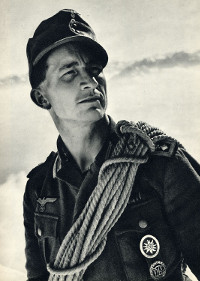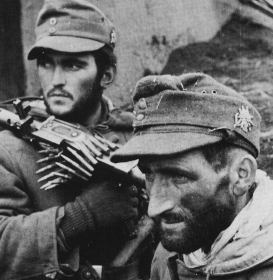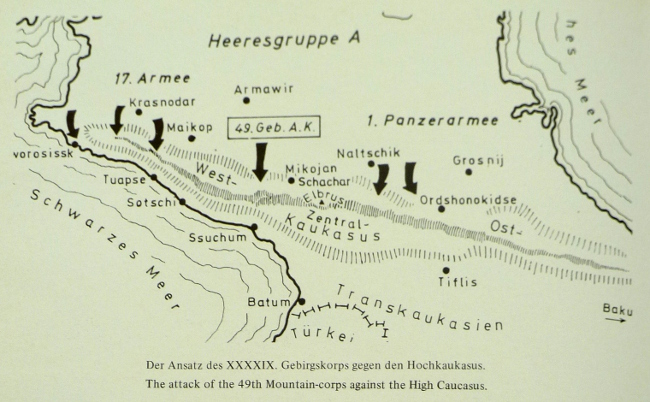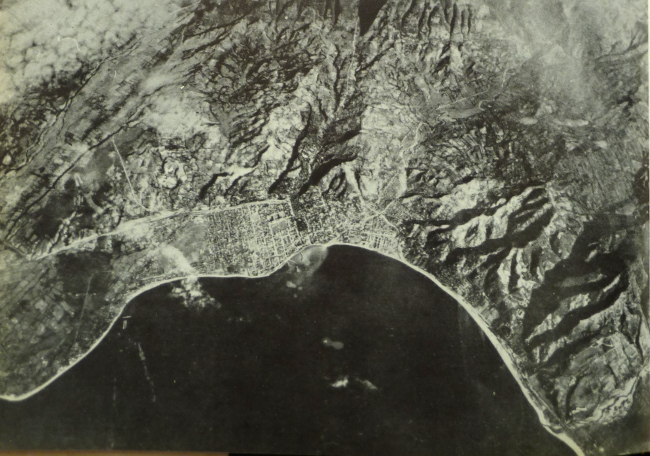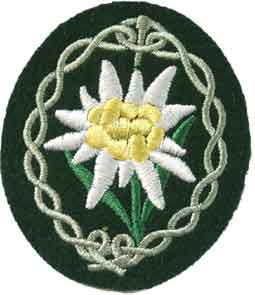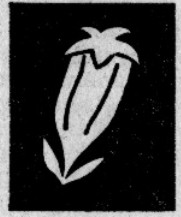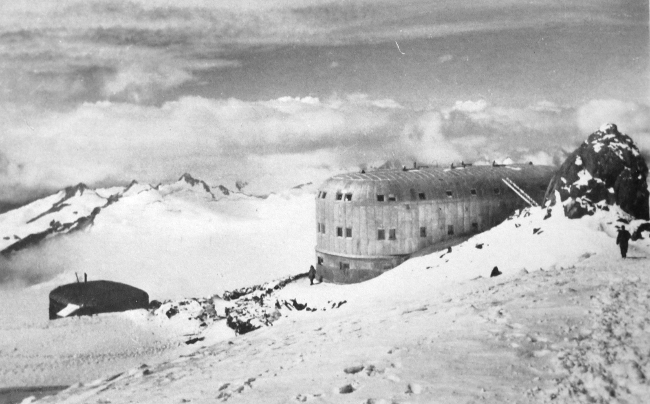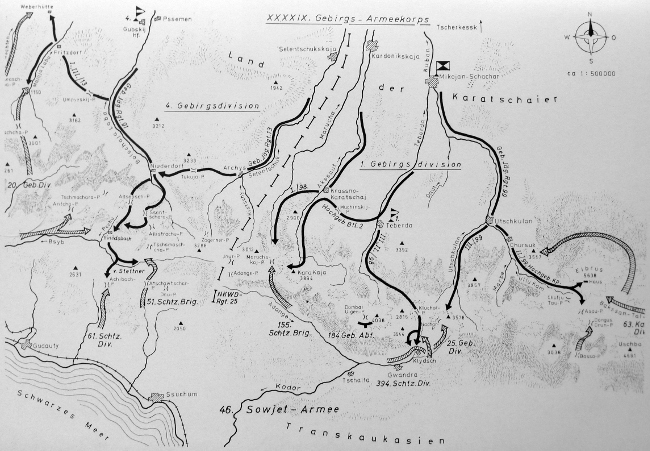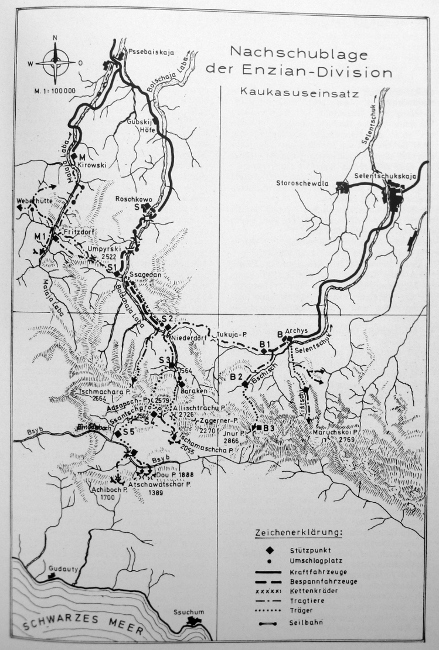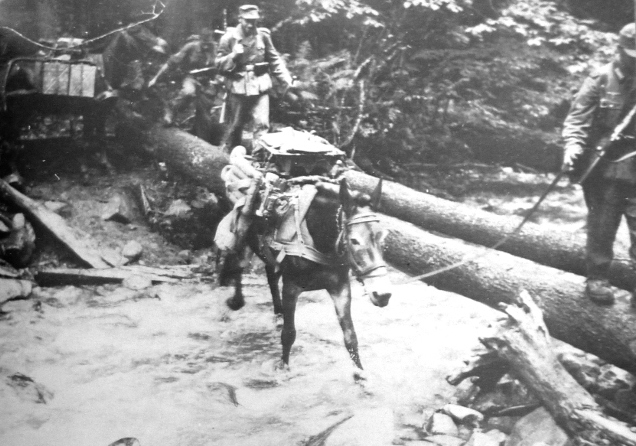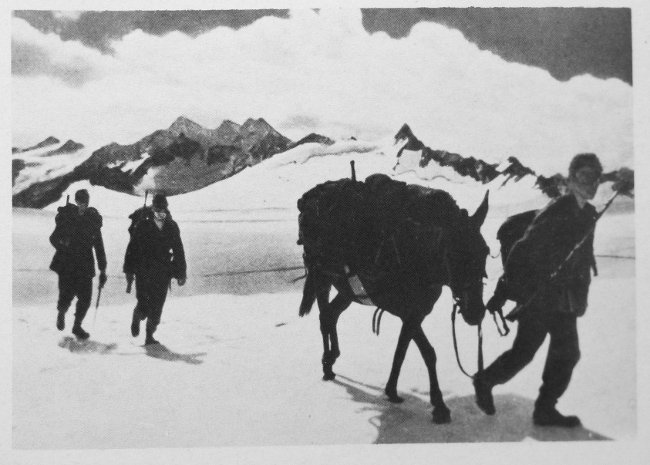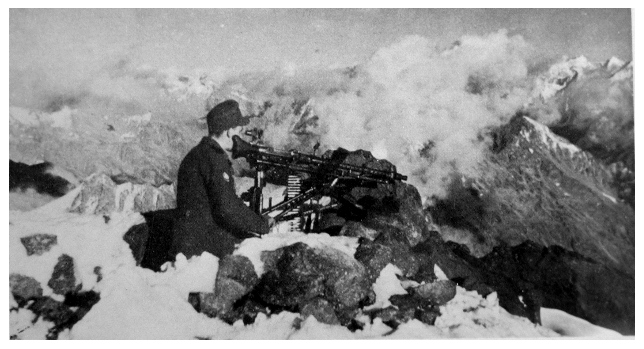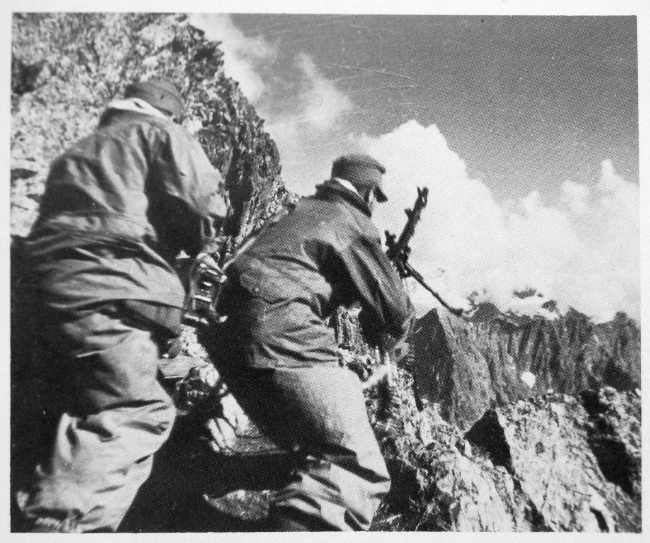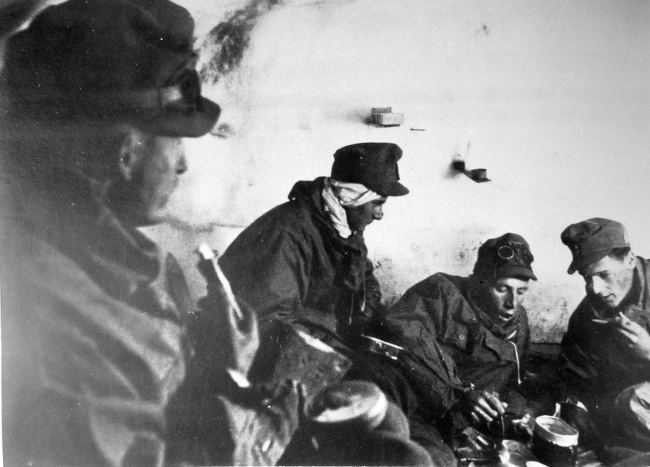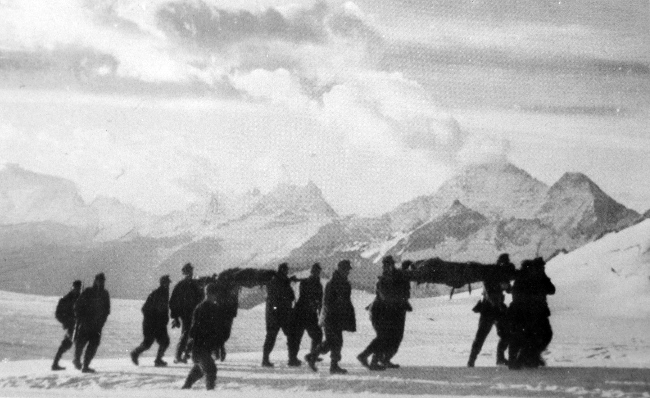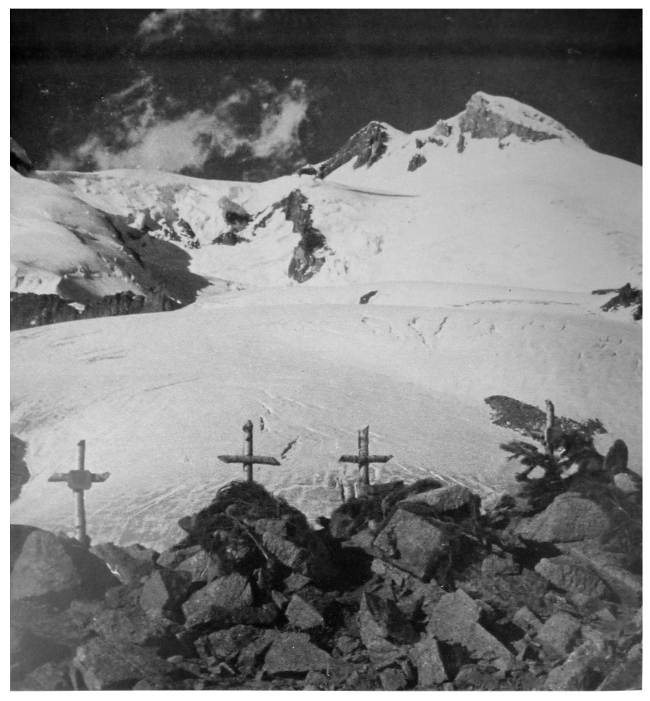The
GERMAN PUSH
up into the
CAUCASUS MOUNTAINS
during the Second World War
August 1942 — January 1943
A WORD OF WARNING:
The delicate smell of alpine flowers and the aura of romance (see here, for example) which float over the men of the German Army's elite mountain warfare divisions—who were in any case naturally not as well-groomed as the propaganda of the time suggested—are just as misleading as the glorious "liberation" of the Caucasus by Soviet forces following their retreat.
|
ATTEMPTED |
|
|
|
PROBABLE |
The officers and men of both the 1st and 4th Mountain Divisions are suspected and in some cases were accused of war crimes and direct complicity in the mass murder of Jews, Bolsheviks, partisans and civilians during operations in Eastern Europe, Russia, the Ukraine, Greece and the Balkans during the Second World War—particularly the 1st "Edelweiß" Division, which was complicit in the mass murder of thousands of "Jewish Bolsheviks" in L'viv in the western Ukraine in the summer of 1941, brutally repressed and shot partisans and civilians alike in the Balkans and northern Greece in 1943 (where the wretched dregs that remained of the original unit after its mauling on the Eastern Front in 1942 had been sent to do just that), and took part in the ruthless clearance and deportation to Auschwitz of the entire Jewish ghetto of the northern Greek town of Ioannina in the spring of 1944 (to name only these three outrages).
The Germans were, inevitably, very good at being the "baddies" and committed or were complicit in some truly heinous crimes during the Second World War. As far as the Caucasus was concerned, however, its myriad peoples suffered most horribly at the hands of their own Soviet "liberators", who imprisoned, shot, exterminated and deported entire peoples of "undesirables" in the region following the German withdrawal—often based upon spurious accusations of complicity with the enemy, and always using the isolated actions of a few as a convenient excuse for getting rid of the whole.
In February 1944, for example (for there are so many others), around half a million Chechen and Ingush men, women and children—i.e. all of them—were brutally rounded up in their villages, marched down to waiting cattle trains at gunpoint, and sent away to fight for their very survival on the wintery steppes of Central Asia. The elderly, invalids and others who could not walk were murdered, and the Chechens and Ingush joined the growing list of Caucasian peoples Russia simply wiped off the face of their earth and from the pages of its history books (the "Circassians", the Balkars, the Karachai, the Meskhetian Turks, &c.).
'Between 1926 and 1939,' writes Oliver Boullogh in his Let our fame be great—Journeys among the defiant peoples of the Caucasus (London: Allen Lane, 2010—the most recent and perhaps the best account of these atrocities), 'the Chechen population grew by 26 per cent. In the next twenty years, it grew by only 2.6 per cent. The suffering that caused that statistic is indescribable.'
JUMP TO:
— Prälude: Führer Directive No.45
— 1. The forces in place (National-Socialist and Soviet)
— 2. From steppe to mountains: the advance to the Caucasus and the first ascents
— Interlude: the German ascent of Mt Elbruz
— 3. Over the main ridge: the Germans capture the passes
— 4. Struggling down the southern slopes towards stalemate and retreat
Annex
— A German Gebirgsjäger's experience of the whole affair
(Press the "home" key on your keyboard at any time to return here.)
SOURCES:
The information on this page is obviously somewhat one-sided, for it consists mostly of personal accounts of the fighting written by Germans (mostly Tyroleans and Bavarians) who served with the German Army's 1st "Enzian" and 4th "Edelweiß" Mountain Divisions in the Caucasus between August 1942 and January 1943 (the entire duration of the German Army's presence in the area).
These accounts—( i ) the war diaries of Oberjäger [Lance-corporal] Alfred Richter, ( ii ) the official account of the capture of the Marukh Pass written by Ewald Soltke, a soldier/editor of the Germany Army's 666th [sic.] Propaganda Kompanie, and ( iii ) the memories (carefully edited by historian James Lucas into a single "story") of other, unknown, soldiers—were copied from Roland Kaltenegger's excellent Gebirgsjäger im Kaukasus: Die Operation "Edelweiß" 1942/43 (Graz: Leopold Stocker Verlag, 1997) and the chapter on the Caucasus in James Lucas's Alpine Elite—German Mountain Troops of World War II (London: Cooper & Lucas Ltd, 1980).
Most but by no means all the photographs were copied from Alex Buchner's well-researched and lavishly illustrated Der Bergkrieg im Kaukasus—Die Deutsche Gebirgstruppe 1942 (Friedberg 3 [sic.]: Podzun-Pallas-Verlag, 1979)—a truly excellent and intensely personal book self-published by a veteran of the German operations.
Both Buchner's and Kaltenegger's books also contain detailed maps, some of which are reproduced here.
—
For a 'highly detailed and balanced account of the fighting between the Germans and the Russians in the Caucasus mountains in late 1942' that 'takes advantage of unique access to archival sources' (both German and Russian) and provides 'many valuable insights about mountain warfare... and the military culture of the Stalin era', Alexander Statiev's excellent At War's Summit: The Red Army and the Struggle for the Caucasus Mountains in World War II (Cambridge University Press, 2018, 440pp, with numerous illustrations, maps and figures) could not be more highly recommended.
Prälude: Führer Directive No.45
[abridged]
The Führer and Supreme Commander of the Armed Forces
Führer Headquarters, 23rd of July 1942
Directive No.45
6 copies
= = = = = = = = = = = = = = = = = =
Officers' eyes only!
Transmission only through officer!
Secret!
= = = = = = = = = = = = = = = = = =
DIRECTIVE NO.45
"CONTINUATION OF OPERATION BRUNSWICK"
In a campaign which has lasted little more than three weeks, the broad objectives outlined by me for the southern flank of the Eastern front have been largely achieved. Only weak enemy forces from the Timoshenko Army Group have succeeded in avoiding encirclement and reaching the further bank of the Don. We must expect them to be reinforced from the Caucasus.
A further concentration of enemy forces is taking place in the Stalingrad area, which the enemy will probably defend tenaciously.
II. AIMS OF FUTURE OPERATIONS
A. Army
1. The next task of Army Group A is to encircle enemy forces which have escaped across the Don in the area south and southeast of Rostov, and to destroy them. For this purpose strong fast-moving forces are to move from the bridgeheads which will be established in the Konstantinovskaia-Tsymlyanskaya area, in a general south-westerly direction towards Tikhoretsk. Infantry, light infantry, and mountain divisions, will cross the Don in the Rostov area. In addition, the task of cutting the Tikhoretsk-Stalingrad railway line with advanced spearheads remains unchanged. Two armoured formations of Army Group A (including 24th Panzer Division) will come under command of Army Group B for further operations southeastwards. Infantry division Großdeutschland is not to advance beyond the Manych sector. Preparations will be made to move it to the west.
2. After the destruction of enemy forces south of the Don, the most important task of Army Group A will be to occupy the entire eastern coastline of the Black Sea, thereby eliminating the Black Sea ports and the enemy Black Sea fleet. For this purpose the formations of 11th Army already designated (Romanian Mountain Corps) will be brought across the Kerch Straits as soon as the advance of the main body of Army Group A becomes effective, and will then push southeast along the Black Sea coastal road. A further force composed of all remaining mountain and light infantry divisions will force a passage of the Kuban, and occupy the high ground around Maykop and Armavir. In the further advance of this force, reinforced at a suitable time by mountain units, towards and across the western part of the Caucasus, all practical passes are to be used, so that the Black Sea coast may be occupied in conjunction with 11th Army.
3. At the same time a force composed chiefly of fast-moving formations will give flank cover in the east and capture the Grozny area. Detachments will block the military road between Osetia and Grozny [sic.], if possible at the top of the passes. Thereafter the Baku area will be occupied by a thrust along the Caspian coast. The Army Group may expect the subsequent arrival of the Italian Alpine Corps. These operations by Army Group A will be known by the cover name "Edelweiß". Security: Most Secret.
4. The task of Army Group B is, as previously laid down, to develop the Don defences and, by a thrust forward to Stalingrad, to smash the enemy forces concentrated there, to occupy the town, and to block the land communications between the Don and the Volga, as well as the Don itself. Closely connected with this, fast-moving forces will advance along the Volga with the task of thrusting through to Astrakhan and blocking the main course of the Volga in the same way. These operations by Army Group B will be known by the cover name "Heron". Security: Most Secret.
B. Luftwaffe
The task of the Luftwaffe is, primarily, to give strong support to the land forces crossing the Don, and to the advance of the eastern group along the railway to Tikhoretsk, and to concentrate its forces on the destruction of the Timoshenko Army Group.
In addition, the operations of Army Group B against Stalingrad and the western part of Astrakhan will be supported. The early destruction of the city of Stalingrad is especially important.
Attacks will also be made, as opportunity affords, on Astrakhan. Shipping on the Lower Volga should he harassed by mine-laying. Secondly, sufficient forces must be allocated to co-operate with the thrust on Baku via Grozny.
In view of the decisive importance of the Caucasus oilfields for the further prosecution of the war, air attacks against their refineries and storage tanks, and against ports used for oil shipments on the Black Sea, will only be carried out if the operations of the Army make them absolutely essential. But in order to block enemy supplies of oil from the Caucasus as soon as possible, it is especially important to cut the railways and pipelines still being used for this purpose and to harass shipping on the Caspian at an early date.
C. Navy
It will be the task of the Navy, besides giving direct support to the Army in the crossing of the Kerch Straits, to harass enemy sea action against our coastal operations with all the forces available in the Black Sea.
To facilitate Army supply, some naval ferries will be brought through the Kerch Straits to the Don, as soon as possible.
In addition, Commander-in-Chief Navy will make preparation for transferring light forces to the Caspian Sea to harass enemy shipping (oil tankers and communications with the Anglo-Saxons in Iran).
Signed: Adolf Hitler
|
* |
* |
* |
|---|
ESSENTIALLY, in July 1942 Hitler ordered ( 1 ) 17th Army (under Army Group A) to advance south-east down the Black Sea coast and 'occupy the entire eastern coastline of the Black Sea [sic.!], thereby eliminating the Black Sea ports [primarily Poti and Batumi] and the enemy Black Sea fleet', and ( 2 ) a "force composed chiefly of fast-moving formations" (1st Panzer Army, also under Army Group A) to 'capture the Grozny area' (oilfields), 'block the military road between Osetia and Grozny [sic.], if possible at the top of the passes,' and occupy the Baku area (more oilfields) by 'a thrust along the Caspian coast' [sic.!].
The plan, unbelievably, was to capture a line extending roughly from Batumi through Tbilisi to Baku...
The 1st and 4th Mountain Divisions of the 49th Alpine Corps were to support 17th Army's efforts by advancing due south over the high mountain passes of the western Caucasus, thus flanking and possibly encircling Soviet defences concentrated along the Black Sea coast, and link up with friendly forces around Tuapse or Sukhumi. (A Luftwaffe photo-reconnaissance flight even went as far as photographing the latter town:)
To put it mildly, particularly given the distances and the terrain his forces would have to cross to even try to achieve his fantastic objectives, and to say nothing of increasing Soviet opposition and the growing doubts of his own generals, Hitler's intentions seem somewhat disconnected from reality.
1. The forces in place
German & Soviet
THE GERMANS, characteristically, came to the Caucasus well prepared (on paper, at least): the 49th Mountain Corps (XXXXIX. Gebirgskorps) consisted of an operational s t a f f under General der Gebirgstruppe Konrad—General Lanz commanding the 1st mountain division and General Eglseer the 4th—who had at their disposal specialized mountain s i g n a l s units equipped with mules trailing telephone wire from wooden spools on their backs, linking units along mile after mile of forested valleys and steep, rocky tracks, some less fortunate radio operators spending days atop isolated rocky peaks to act as solitary relays for messages passing up and down the line; highly-trained mountain a r t i l l e r y batteries with specially-designed lightweight howitzers capable of being dismantled and transported along rough terrain, complete with their heavy rounds of ammunition, by teams of as few as 10 mules, and able to fire eight 75mm high-explosive shells per minute at enemies as far as 9 kilometres away; detachments of highly-skilled mountain e n g i n e e r s capable of moving mountains (almost literally) and building roads, bridges, motorized cable-railways for bringing up supplies and evacuating the wounded, barracks and bunkers, down in the valleys or high up above the snowline on some windswept pass; specialized mountain l o g i s t i c a l and supply units, some of them roaring around on half-tracked motorbikes designed to transport loads of up to 250kg along steep mountain tracks, most of them ankle-deep in mud with a bad-tempered mule train in tow; not forgetting the several thousand elite G e b i r g s j ä g e r themselves, tough and taciturn mountain men from the Alps (initially, at least) equipped with rifles, machine-pistols, light and heavy machine-guns, sniper rifles, hand-grenades, light and medium mortars, wheeled 20mm anti-aircraft cannon, ice-axes, miles of rope, bags of karabiners and pitons, hobnailed boots, plenty of tobacco, no doubt enough brandy and dirty jokes about their person to warm up an entire platoon, and a small white flower on their caps and uniforms.
|
* |
* |
* |
|---|
|
|
|
|---|
The men and officers of the German Army's 1st Mountain Division wore an E d e l w e i ß (Leontopodium alpinum)—a small, delicate white flower long associated in the Germanic mind with the romance and magic of the high Alps, and the symbol, to this day, of Germany's mountain troops—whereas the tactical emblem of the 4th was an E n z i a n (probably the Snow Gentian, Gentiana nivalis).
|
* |
* |
* |
|---|
But it wasn't all flowers: After a long and arduous journey south to the mountains along dusty roads and under the blazing summer sun, down from a distant crossing they had forced 600km away over the Don River near Rostov, the German mountain troops needed to rest and regroup. Worse still: the 2nd Rumanian Mountain Division and three divisions of Italian Alpini were ordered to detach themselves from the Corps and head for the front around Stalingrad; a rifle battalion and a battery of mountain artillery were transferred to the 1st Panzer Army; and the 4th Air Corps, whose support the mountain troops had been firmly promised, was transferred to Italy.
From the outset, pitted as it was against the might of the Red Army and the Caucasus Mountains and the unbelievable ambition and criminal stupidity of its political and military masters back in Berlin, the German Army's 49th Mountain Corps had all the striking-power of a flea, and its pathetically small, isolated fighting units were swallowed up by the remote mountains and valleys of the Caucasus.
THE SOVIET FORCES, on the other hand, certainly seem to have started out much less well-prepared: 'Russians, Caucasians, Grusinians, Usbekians and Turkmenians... With the exception of a few newly-formed units the enemy had no genuine mountain forces... His units were mostly quickly [cobbled together, and were] of different strength, often badly trained and ill-equipped for the mountains.' See in particular Statiev's At War's Summit (ref. above) for descriptions of the truly appalling conditions in which Soviet troops were deployed and expected to fight the well-trained and equipped Germans. But despite these disadvantages, 'the Soviet soldier proved—like everywhere on the Eastern Front, also in the Caucasus—to be a stubborn opponent... without exception excellently armed.'
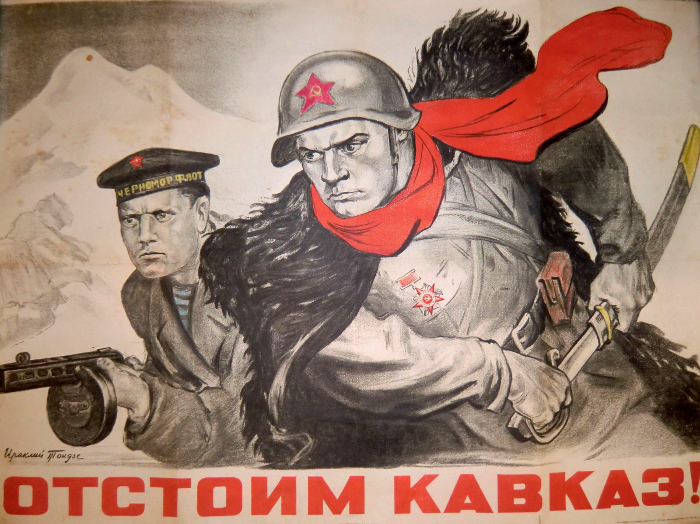
Although the mountain warfare skills of the Soviet infantryman deployed in the Caucasus were most likely not as developed as the Germans', what he lacked in professional ability he made up for in numbers and determination. Combined with its shorter supply lines (a vital advantage in any conflict, but perhaps particularly so in mountain warfare), the Red Army's near-inexhaustible reserves of manpower positively swamped the ant-like Gerbirgsjäger units—a crushing, vice-like disadvantage which an almost complete lack of resupply and reinforcement on the German side rapidly tightened.
Soviet forces were also increasingly able to benefit from supply drops from the air and close air support—notably provided by the dreaded ground-attack Ilyushin Il-2 "Shturmovik", against which the German mountain troops were unable to defend themselves. This was to prove a crucial advantage in the long run, for with the exception of a few Fieseler Fi-156 "Storks" (Storch, an extremely light, practically unarmed and remarkably slow two-to-three-man 'plane, mostly used to transport senior officers and fly out a handful of "lucky" casualties) the Luftwaffe was practically absent from this theatre of operations and the Russians never lost their complete domination of the skies above the Caucasus.
2. From steppe to mountains
The German 1st and 4th Mountain Divisions' advance up into the Caucasus
(a personal account of operations during the month of August 1942 up to the 5th of September)

Sowjetunion, Kaukasus.- Konvoi von Kettenfahrzeuge in Hügellandschaft; PK 666
(1942/43, German Federal Archives Bild 101I-031-2406-15)

Sowjetunion, Kaukasus.- Deutsche Gebirgsjäger im Schnee, Rast; PK 666
(22 December 1942; German Federal Archives)
A map copied from Kaltenegger (see above):
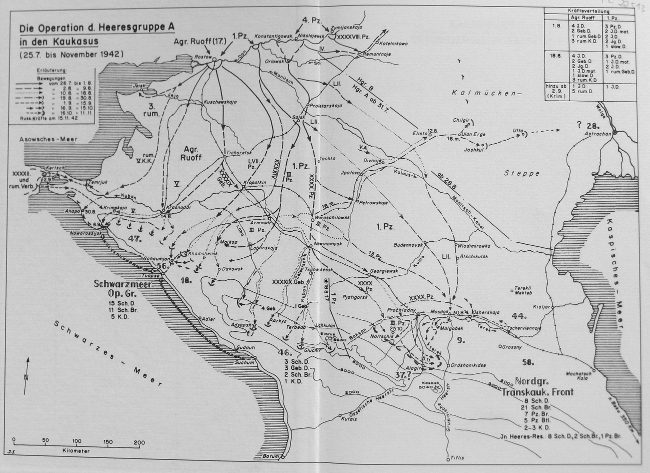
A detailed map of the operations of Army Group A
(17th Army, 1st Panzer Army & 49th Mountain Army Corps)
between July and November 1942
(click to open a larger version in a new tab)
From the war diary (quoted in Kaltenegger, pp. 111-134; see above; my translation from the original German) of O b e r j ä g e r A l f r e d R i c h t e r, who served with the 2nd Hochgebirgs-Jäger-Batallion's headquarters staff. 'Besides the fighting at the front, this sensitive painter—whose creative work would later see him awarded a professorial chair in post-war Austria—also described the landscape and people of his surroundings as well as the simple, human concerns and needs of the average frontline soldier.'
[August 1942]
Rostov on the Don [is] completely burnt and destroyed. Now we cross the Don and advance towards Asia. We halt in the village of Kulishevka, outside Bataisk. Today's stage involves marching 90 kilometres—not much, but quite an ordeal for the drivers given the terrible state of the roads. Like most of the others, I lie down in a field and sleep.
3rd Company ["Coy"] reported two serious accidents during loading in Innsbruck [in Austria]: A cart transporting hay was burnt to a cinder when the hay, which was piled too high, came into contact with an overhead power line and caught fire. Shortly afterwards a goods train coming down from the Brenner [Pass] crashed into the transport train as it stood alongside the loading ramp, ramming into each other the first three or four flatbed cars upon which lorries had just been loaded. 1 man was instantly killed in the accident, 2 others soon died of their injuries, and 15 men, some of them with crushed legs, were evacuated to hospital. The many women who had come to bid their menfolk farewell at the station apparently also witnessed this ghastly accident.
The Batallion seems to be under a dark cloud: 4 men fell to their deaths, as it later turned out, then the other 3 and a considerable number of wounded and sick in the infirmaries. Several others also had to be left behind in Taganrog [a port city on the northern shores of the Sea of Azov]. [...]
20 August
At 05.00 we resume our march towards Kushchiovskaia. We halt at mid-day in Pavlovskaia. It is very hot. We are lucky to be able to wash ourselves with a bowlful of water. Our average speed is slow, around 20 km/h. We are unable to reach our objective and stay in Arkhangelskaia. Today we covered 191 kilometres.
21 August
We rise at 04.00 and get going again at 05.00. We pass through Kropotkin. The friendliness of the local people is surprising, who wave at us and offer us food. During a short halt I enter a farmhouse, and am immediately given tomatoes and plums. A woman hurries to fry some pancakes in oil for us. At 08.00 we cross the Kuban [River]. The bridge was apparently only relaid a week ago. The scars of fighting are still visible around us. Then we are shown proof of the vehemence of the Stuka [dive-bomber] attacks as we drive past kilometres of destroyed transport columns. The effect of the bombs upon the munitions transports must have been terrifying; [the force of the explosions was such that] sections of railway track are curled like thin wire, and in some places lie 100 metres away in fields along the railway line along with iron carriage wheels and heavy munitions. Some railway cars have melted along with their loads into shapeless lumps of metal.
The lorries need to fill up with petrol and the men immediately put the long halt to good use and go for a swim. Two hours of paradise: We race around stark naked through the water-meadows along the Kuban and swim back and forth through the river's warm, deep waters. On the opposite shore we find vegetable patches full of tomatoes, onions and herbs. Every man eats and takes what he can carry. The women at work in the surrounding fields stare dumbfounded at our naked doings. I don't know how many times I swim across the river with strings of onions and herbs around my neck and tomatoes in my hands to share these delicacies with those who cannot swim.
I have another opportunity for a swim in the evening. A thunderstorm has made driving up the sloping road impossible. We halt in [the village of] Protshnovkopskaia before [the town of] Armavir. We gorge ourselves on plums and greengages we find in an orchard on a small island in the river. We quickly organize ourselves and soon chickens, geese and even pigs are gathered. I spend the night on the 'bus. Today we covered 106 kilometres.
Interlude: the German ascent of Mt Elbruz
5,600m, 21st of August 1942
From Lucas's Alpine Elite (see above; pp. 133-134):
THE REAL ASCENT TO CONQUER THE ELBRUZ peak began on the 17th of August, and by last light of that day the group which would be making the assault had reached the point past which all portering would have to be carried out by the men themselves. Ahead lay a glacier and behind that vast sheet of perpetual ice lay the twin peaks of the mountain. Last light comes early in the mountains, and although it was only 5 in the afternoon twilight had already fallen when on the following day the men, each of them carrying between 35 and 45 kilogrammes of equipment, reached a [120-guest] hotel [built by the Soviet Union in 1936 at an altitude of 4,160m] which they named the "Elbruz Hut". There the actual assault group and the portering groups rested. An attempt was made on the 19th of August to rush the peak, but the attempt was driven back by shockingly bad weather conditions. The Elbruz was not to be taken that easily.
Like an oversized Pullman carriage, the Elbruz Hut (right) and its kitchen (left)
stand on a rocky plateau in the middle of the 800m-wide glacis of ice
of the Asau Glacier
The point group did cross the giant glacier, however, and began the final assault at mid-day on the 20th of August, but was driven back and rested in the Elbruz Hut until the following morning. At dawn on the 21st of August the assault group set out. Thick fog forced the climbers to march on compass bearings and before the journey had been half completed bad weather set in. By now it was a case of win or turn back, and the assault group forced their way forward in fog, with visibility of only a metre, and through a blinding snowstorm. By 11 in the morning the summit had been reached, the national flag raised and the divisional insignia nailed to the flagstaff. The Gebirgsjäger of the German Army stood on the highest peak of the Caucasus range.
"C'est magnifique, mais ce n'est pas la guerre."
22 August
We only leave at 12.30. I go for another swim in the Kuban. The thunderstorm has cooled things down. The landscape is changing; it reminds me of hilly parts of Bulgaria, only here the landscape is broader and flatter, bare and covered in steppe-grass and with table-like plateaus. Our surroundings are sparsely populated. A bad section of roads holds up our convoy for so long that today we only cover a total of 72 kilometres.
We have nicked a calf and a pig, and everyone gets a helping of goulash. Tonight I prefer to sleep in a tent rather than on the 'bus.
23 August
We press on, driving up and down endless hills. The road we are following could hardly still be described as such; it is marked as being no more than a "Panzerstraße", and was indeed probably only created by the advance of our tanks. The clayey ground is as smooth and hard as asphalt. Woe is he who tries to drive along it after it has rained! Deep, muddy pools constantly hold up the column's advance as the vehicles need to be unloaded before they can tackle them. After a long detour we rejoin the valley of the Kuban [close to the village of] Borszukovskaia. We cross the main railway line in Nevinnomiskaia. We [then] drive up the Kuban, once again along bad tracks and across country through a bleak, treeless landscape. It is still light when we reach Cherkessk and set up camp.
24 August
We are to be transported by 'bus as far as the "roads" will allow. We wait for fuel and pack our marching-bags in the meantime. Our steel helmets and the horrible gas-masks are left behind along with other superfluous equipment and clothing we have brought from Germany.
In the afternoon our transports follow the old Sukhumi Military Road into the mountains. The mountains of the Caucasus are different from the Alps: there is only one main ridge, joined at right-angles by long secondary ridges and valleys. We have barely left the plains behind and reached the first soft foothills when we encounter a different kind of people: The men have beards and wear wide-brimmed hats similar to the old traditional Tyrolean ones and dark brown sheepswool coats. Their dark faces seem hard under their low hats, but not unfriendly. Most of the women cover their heads with dark-coloured scarves tied around their necks, like the women in Rumania. The houses are primitive but proof of their owners' strong sense of order. Tiny huts cling to overhanging rock-faces like swallows' nests, their clean, lime-washed walls painted white. The geology of the Kuban River's exit from the mountains is very interesting: layers of chalk covered in clay, in other places red earth between blocks of rock æons-old. We unfortunately simply drive past all these beautiful sights, and I regret not being able to draw or photograph them. We pass through Kamennomostskii, apparently a mining-settlement. Large modern buildings stand among a multitude of small one-family houses. The place has been in German hands since the 15th of August. Our road now winds its way through a narrow, sparsely-populated valley. The road is as bad as everywhere else. We arrive at journey's end as darkness falls—the sanatorium of Teberda. The omnibuses are unloaded, and we set up camp under some birch trees in a beautiful park.
25 August
We are woken up at 05.00 by the sound of bombs exploding. A Russian 'plane has come to pay us a visit. Teberda is [a sanatorium to which people come for the clean mountain air]. The sanatorium's buildings, which resemble boxy European hospitals, are modern only in appearance and show nothing of the cleanliness which we would expect within. They are mostly filled with ill Russian children who have no intention of letting repeated aerial bombardments ruin their summer stay. These are naturally not targeted at them, the bombs being instead aimed at the headquarters of the 1st Gebirgsjäger Division (General Lanz) which have been set up here.
The maps in divisional headquarters tell me much about the results of our military operations to date: A Hochgebirgstruppe of picked men from the division under the orders of Hauptmann [Captain] Groth reportedly climbed to the summit of Mt Elbruz (5,633m) on the 21st [of August] before going into action against the enemy—a double achievement for the brave Jägers. A batallion has reportedly already crossed the Klukhor Pass and is said to be fighting on the southern side before [the settlement of] Klitsh. (I had hitherto thought this would be our responsibility.) [Our] batallion alone is currently in action against two newly-arrived Russian mountain divisions. Hard fighting has been reported. On the Russian side stand elite troops such as a regiment of officer cadets [Fahnenjunkerregiment], reportedly none of whom could be captured and who had to be killed one by one. Sharpshooters are also a dangerous adversary. An advance down the southern slopes of the Caucasus is said to still be possible but would be pointless, for German troops have been unable to push forward to the east [of our positions] or in the western Caucasus. Which makes us the tip of a southern-facing wedge. We shift our camp to another site which overlooks Teberda and is better camouflaged. But I barely have time to settle in and resume my urgent mapping duties when the Russian 'planes return. A bomb explodes close by. Once again I have to relocate my mapping station. I shelter under a thick tree so as to avoid attracting attention to myself with my light-coloured maps.
The landscape is superb, and reminds me of the Alps. The deciduous trees of the valleys give way to forests of pine higher up.
26 August
Up at 04.00. Our "work" begins. 1st Coy under Hauptmann [Captain] Schmid is to march off immediately and cross the Dombai-Ulgen Pass. We set off at 07.30 with 2nd Coy and the communications detachment ahead of us and 3rd Coy bringing up the rear, and head in a westerly direction over the Mukhin Pass (2,744m) towards [the settlement of] Krasno-Karatchai. All of us walk rather unsteadily, being out of practice on account of the long train and 'bus journeys. Our heavy back-packs make matters worse, as every man must carry four days' supplies. The Russian 'planes appear to have regular working hours. They came again in the morning and then later during our march in the afternoon. We have to take cover several times so as to avoid betraying our movements. We encounter shepherds squatting on top of boulders who probably spotted our advance ages ago. They rise rather grandly to greet us. They are fine-looking men, tall and of aristocratic bearing despite their shabby clothes. It begins to pour with rain during our final ascent. We reach the pass at 15.30. The descent [on the other side] is steep and hard on the knees. We halt, exhausted, on a rocky spur in the Marka Valley and set up camp for the night. My abdominal muscles really hurt. My colleagues from the mapping section and I are on duty tonight. Delicious-smelling coffee (40% coffee beans) improves the evening. As I am on duty tonight I cannot crawl into my sleeping-bag and am freezing, particularly my feet.
27 August
I am on guard duty from 04.00 till we leave. We wait until around 11.00 in the shepherds' camp of Krasno-Karatchai for the order to push on southwards up the Axaut Valley. We learn that two companies of the 98th Gebirgsjäger Regiment have surrounded Russian forces in the parallel valley to ours, the Marukh Valley. The Marukh Pass is reportedly held by a Russian regiment with artillery and mortar support. Our batallion is to advance towards the Pass from the east. The C.O. already indicated the locations of various Stützpunkte during the preliminary operational briefing in Teberda. These have been indicated by letters beginning with "a" on the map. 3rd Coy is to advance to Point "d" where the Malaia [small] Teberda Valley meets the Axaut Valley. Batallion H.Q. is to march to "c", 18-20 kilometres to the south of Krasno-Karatchai. The valley is amazingly beautiful. Although we have no particular heights to cross, yesterday's exhausting march makes walking sheer agony. We are happy every time we are given the opportunity to rest for a while. These halts, combined with our constant efforts to take cover and hide from Russian spotter 'planes, slow down our advance. Night has already fallen by the time we reach our positions by "c". It is raining, but we are ordered not to light fires (the enemy might spot them). Now begin my additional duties as the unit's diarist. The C.O. sends out order after order until late at night, in addition to which I have four maps to draw. Five men to a tent is already quite a squeeze, but having to draw maps by the feeble light of a little candle while sitting on the ground without being able to stretch one's legs or back is even more demanding than marching.
28 August
I leave my assistant to continue at 01.00 as I can no longer remain seated. I am woken up at 03.30, and at 4 I go with the C.O. up the valley towards Stützpunkt "d"—a collection of huts built at an altitude of 1,911 metres to serve a tungsten mine and in the midst of a beautiful forest whose trees reach high up the flanks of the neighbouring mountains. Above 1,200m the flora here in the Caucasus begins to differ from that in the Alps. This is no doubt due to the Caucasus's more southerly latitude. From "d" there is a lovely view of the valley all the way up to the Axaut Glacier and [Mt] Axaut (3,908m).
We encounter women and children in the barrack-like huts, presumably relatives of the men working in the nearby mine. I am quite surprised when one of the women walks up to me and asks me in German 'Do you by chance have a picture of St George?' She then added 'You know, I am religious, I am these children's teacher.' I am unfortunately unable to accede to her request. The women and children are sent out of the valley. In one of the buildings I find a theodolite. The women are determined to take it with them; perhaps they consider it a particularly valuable piece of equipment. We have no need for it as far as I can see, and I want to let the women keep it. But Bauer [the C.O.] orders me to hold on to it. So I curtly refuse the women their request and chase them away. My assistant and I set up the mapping station and take up our own quarters in a room in one of the huts. The C.O. takes over two rooms next to us—his bedroom and office—and the communications unit and radio operators settle in the hut opposite.
Footbridges are laid over the Axaut River's many streams.
An attack on the Marukh Pass was planned for today, but the operation is delayed until the whereabouts of the enemy's positions can be precisely established. We carry out a lot of reconnaissance today in all directions. We begin to receive reports in the evening: 3rd Coy report that they have advanced to the Axaut Glacier and that their patrols have taken up positions on some ridges, but they report no contact with enemy.
Lt Kelz from 2nd Coy reports that he and his patrol (who were advancing from "d" towards [Mt] Kara-Kaya) have succeeded after heavy fighting in taking the ridge which branches off eastwards from the main north ridge by Height 3,163[m]; the north ridge is reportedly held by the Russians, who have apparently deployed sharpshooters between the rocky outcrops of a parallel ridge.
The remaining patrols report having reached their objectives, but fear they will be unable to continue because they are running low on ammunition.
The C.O. plans to attack the north ridge of Kara-Kaya tonight and "throw" the Russians. Outlying company elements are to be grouped and deployed against Point "e" (3,080m) to the north of Kara-Kaya. Ammunition and supplies are to follow tomorrow. I am extremely busy with maps to be copied and sketches to be drawn. As I only have the use of my small box of things for sketching and drawing and the roll of maps I carry with me, the work takes me three times as long as it normally would. The entire H.Q. staff has now arrived in the Batallion's forward command post by Point "d".
29 August
Our night's sleep in the hut was ghastly; we lay on the floor, sleepless, as bed-bugs tormented us most horribly.
11.00—we have taken cover and are waiting for the Russians. H.Q. staff are to cover the withdrawal of 3rd Coy, who are still unaware of the fact that the enemy has pushed back our patrols everywhere and is threatening Point "d" down the countless streams and beds of shingle of the Axaut Valley. The feared shortage of ammunition has begun to make itself felt. The plan was too optimistic: sending a unit into combat in the high mountains without baggage and pack-animals—i.e. deprived of fresh ammunition and supplies—is a gamble. We have left the huts. The C.O. is with 3rd Coy. The result of yesterday's operations: 2 dead (Oberjäger Schenk from 2nd Coy and Jäger Veith from H.Q. staff), 5 wounded, 2 missing, and 1 Russian prisoner. In the morning comes a message reporting a further 5 dead and 7 wounded on our side, and 10 Russian prisoners.
The prisoners who were brought to us are equipped rather haphazardly and are weak with hunger. Whereas reports claimed well-equipped mountain troops were fighting on the Russian side. They wore grey uniforms, mountain boots and hats similar to ours.
The mid-day break is strangely tense. The uninterrupted sound of fighting since 04.00 up on Height 3,021, high up above a grassy slope to our west, has stopped. Have our units fired all their ammunition? The sound resumes after a while. Have the Russians been pushed back? We return to our hut and move Batallion H.Q. 300 metres back among the trees. I had just erected my tent over a hastily-dug foxhole lined with bracken to make sitting and drawing maps more comfortable when I was suddenly racked by a heavy bout of fever and a sharp pain in my back and sides. I can barely straighten myself. The C.O. has returned in the meantime. H.Q. goes back to action stations again. I am forced to remain lying in my foxhole. The C.O. comes to look for me, but is equally at a loss to explain my condition.
30 August
My fever has gone, but not the chest pains; my lower back is also painful. At least the night in the tent was more comfortable than sleeping in the nest of bed-bugs [the hut]. All the H.Q. staff spent the whole night securing the Axaut Stream, and I spent the night alone in camp. The night was calm. The Russians—who had advanced up to the stream and were calmly digging in on top of a knoll under our very eyes—were forced down from the knoll by fire from our positions and retreated into the forest on the other side of the stream. The shooting is getting closer to our camp.
Our night's rest disappears in an instant as some excitable youngster begins to shoot and throw hand-grenades in front of the huts. Every man goes to action stations. Although my fever has gone, I still find breathing painful. Two machine-gunners and I are ordered to secure a footbridge over the Axaut during the second half of the night. I am struggling not to fall asleep. The others are not finding it any easier: During my quick walk of inspection I encounter sleeping infantrymen here and there in various positions. The moon shines brightly and all is quiet except for the distant sound of fighting which floats down to us from the upper end of the stream.
31 August
More and more Russians are deserting and coming over to our lines. They say many more of them would come were not some of them afraid of their [political] commissars. They are told the Germans shoot all those who surrender to them.
I make myself some good coffee. We still have to rely upon ourselves for cooking. Although an ox was slaughtered for meat and soup, we do not have enough cooking utensils [and pots and pans] to regularly cook for the headquarters staff and our field-kitchen has still not arrived. The tinned food [we are issued with] is absolutely revolting.
I initially intended to catch up on my sleep after my coffee, but the good weather prevents this. My assistant, Herbert Pitschel, and I busy ourselves with some "housework": we dig to make our foxhole deeper and use planks to build up the sides of our tent, something which I learnt to do with the Scouts. We can now even set up a work-table in our tent. We take our work to heart and complete our new quarters by mid-day. Upon which the C.O. returns in the afternoon and orders H.Q. to relocate back into the infested huts immediately. I am seething, not so much because of the wasted effort as because of the plague of bed-bugs which awaits us. The weather changes. I notice that the weather changes much more abruptly here than it does in the Alps. The Russians withdraw. They will presumably try to cross into our valley further down from a neighbouring one.
The Russian prisoners and deserters are gathered close to us by Point "d". Today there are 18 prisoners and 14 deserters.
1 September
It has poured with rain all night. The men up in the [combat or observation] positions are having a really hard time. [Russian] deserters arrive soaked through and so weak with hunger that they are barely able to stand. This morning two of them fell into the stream as they tried to surrender and drowned. An event which took place yesterday showed the extent of what men are able to bear: Hauptmann [Captain] Geyer, who entered the valley at the head of his 2nd Coy a day before we arrived, had three civilians shot.
Yesterday two civilians were found hiding [among the banks of shingle] in the riverbed again. They turned out to be two of the three who had been shot. They fell into the stream with punctured lungs, hid among the rocks for a few days, and subsequently crawled out.
The prisoners and deserters all claim in unison that they were only given half a kilogramme of bread and two kilogrammes of raw meat to last them for five days, meat which they were reduced to eating raw because they were forbidden to light fires.
In the evening 2nd Coy takes Point "e" (3,080m) and the ridge to its north and south (which the Jägers have nick-named "the Red Wall")—an important position for the further advance towards the Marukh Glacier and the Pass. The company captured machine-guns, mortars, rifles, machine-pistols, hand-grenades and ammunition as well as 26 prisoners and 5 deserters. 2nd Coy reports that the enemy is retreating everywhere.
2 September
I slept on my work-table, a roughly-assembled surface made of three planks. To some extent this did indeed enable me to escape from the bed-bugs, particularly close to the walls. The weather is clearing. A peaceful day without fighting. The Kan-Kaya Valley is cleared of stragglers. 150 prisoners are brought to Batallion H.Q. They are locked into an old barn, whose door made of planks is locked by a simple wooden peg. We are barely able to care for them as we are not being resupplied ourselves and our reserves are running low. All we can offer them is a thin soup made of beans. They throw themselves at empty tins to lick out the last scraps of food, and cook what is left of their own meagre combat rations over little fires which they light all around our positions. They are to be used as porters. A patrol under Leutnant Dingler and 4th Coy's Alpingruppe [probably 4th Coy's specialized high-altitude detachment] advances up the Axaut Valley and take up positions in a gap in the ridge we have named the Kara-Kaya Gap (I 103). From there a flanking attack on the Marukh Pass can be attempted.
The stream has really swollen with yesterday's heavy rain and has swept away the footbridges. The prisoners are put to work replacing them. In the evening I pull a drowned man in civilian clothes out of the stream with the help of some of the Russians working in the riverbed and we bury him in a bank of shingle. I do this because I have discovered that the "spring" close to our camp from which we drink and fetch water is not a spring at all—rather a small branch of the main stream which flows under some rocks.
3 September
A quiet day like yesterday. The weather has improved slightly. My people and I are kept frantically busy with maps to be traced and reports and orders to be drawn up.
Because the Batallion is independent, that is to say not part of a regiment, it comes under direct divisional authority. Division [H.Q.] issues all our orders and instructions, and we send them all our messages and reports. Radio communications are severely disrupted by the mountainous terrain, so messengers also cover the long distance to Division H.Q. in Teberda over the Mukhin Pass on foot. It takes them two days to go there and come back—hardly a convenient solution when the message is urgent. The Batallion is therefore not only "independent" in terms of unit hierarchy: up here it is forced to rely solely upon itself. The C.O. is constantly on the move in order to keep himself informed of and involved in every development as quickly as possible. We are still cut off from our rear areas; no post or radio communications reach us.
During a pre-operational briefing the C.O. outlines his plan to attack the eastern flank of the Marukh Pass from the Kara-Kaya Gap (I 103). He asks that I be present during the briefing in order to clear up any potential confusion over the names of gaps, ridges and other geographical points. The company, patrol and combat commanders have to rely upon the completely useless 1:200,000 maps and have resorted in their reports to using names of their own for various points. We now issue them with the basic maps which I drew from our only copy of the excellent Russian 1:42,000 map—war booty which the C.O. is always reluctant to part with—and upon which I have indicated all the [necessary operational points].
4 September
A beautiful morning but unfortunately another rainy day. The C.O. climbs up to the Kara-Kaya Gap along with some elements of H.Q. and 2nd, 3rd and 4th Coys' Alpinzügen [high-altitude detachments]. The Batallion's Second-in-command, Oberleutnant Jakoby, and I must remain in the Batallion's command post.
[The body of] Leutnant Schindler from 2nd Coy, who was shot in the heart on the 30th of August, is brought down.
We are still living off nothing else but Russian tins of food which we found along with some flour in one of the huts. The tins mostly contain beans, which are covered up to a third in beef fat; very filling, but very hard to digest if one is unable to move around a lot. I think the tins of beef have given me diarrhoea.
5 September
The operation to storm the Marukh Pass began at midnight. Down here in "d" we are given a running commentary of operations as units take up their positions and begin to attack the pass: 3rd and 4th Coys' combat groups crossed the ridge by J 103 at midnight and are advancing upon J 120, 121 and 112. The first two points are taken during the morning. Possession of J 112 would deny the enemy the ability to resupply or reinforce his positions atop the pass, and a column-strong attack succeeds in throwing back the enemy and seizing the point. At 14.20 a message comes in reporting that Jägers from 4th Coy have managed to fight their way to within 50 metres of the pass. Enemy forces atop the pass have dug in. Another report quickly comes in: Marukh Pass taken by storm; 400 to 500 prisoners, only 10 to 20 Russians managed to escape; 60 to 80 Russians killed; own losses slight, for the time being confirmed to be Lt Pilarczyk and 1 man dead and 3 wounded, among them a sergeant with severe injuries.
3. Over the main ridge
The Germans capture the passes
In detail
The capture of the Marukh Pass
(2,746m; VI-IX)
September 1942
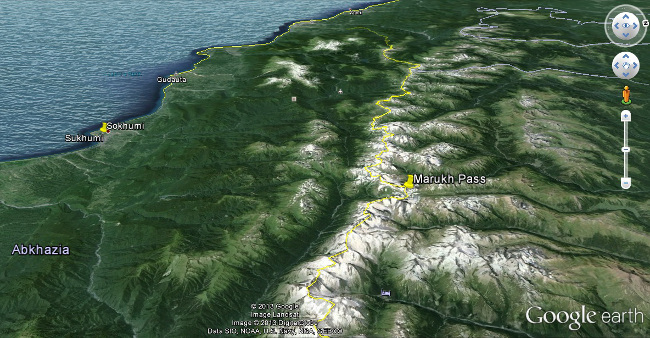
A satellite view of the Marukh Pass, taken by German mountain troops in September 1942,
a mere 50km north ("as the crow flies") of the town of Sukhumi on the Black Sea
According to Roland Kaltenegger—the author of the excellent and very comprehensive (and full of fascinating maps) Gebirgsjäger im Kaukasus: Die Operation "Edelweiß" 1942/43 (Graz: Leopold Stocker Verlag, 1997)—the capture by German mountain troops in September 1942 of the Marukh Pass, which stands 2,746 metres high close to the upper end of the Kodori Gorge, is a classic example of a high-altitude battle in mountain warfare. Its account is in any case no doubt typical of most of the high-alpine fighting which took place in the Caucasus mountains during the Second World War.
In recognition of this, Kaltenegger reproduces the official account [my translation] of the German capture (by 1st Batallion/98th Gebirgsjäger Regiment under Major Bader) of the pass; this account, a rewritten version of the original military report (which is no doubt a lot less literary and much more matter-of-fact), was embellished by Ewald Sotke—a "soldier-editor" serving in the German Army's 666th Propaganda-Kompanie, which was attached to 17th Army from 1942 to 1945.
|
* |
* |
* |
|---|
Prop.-Komp. (mot) 666
Sdf. (Z). Ewald Sotke
Maruschkoj-Paß (2,756m)
8. IX. 42.
Radio report
WE ARE NOW UP ON THE PASS. We have set up camp between the rocks on either side of the saddle. Forward emplacements and reconnaissance patrols are securing the pass on the side facing the enemy. We are still aglow with the resounding victory of three days ago. It was a day just like today, brilliant with sunshine. A sky as blue as in fairy-tales was stretched over the peaks, glaciers and rocky pinnacles which surround the Marukh Pass in the wilderness of the Caucasus mountains.
In this world of high peaks and ranges whose beauty would bewitch any keen mountaineer, a 12-hour battle took place which ranks as a classic example of high-altitude combat—a battle which ended with the capture of one of the most important crossing-points in the western Caucasus and the total defeat of the enemy.
Intelligence and reconnaissance had enabled possible routes up to the pass and enemy positions to be worked out and mapped days beforehand. The pass, which runs from north to south, crosses the main range of the Caucasus, which here stretches from the north-west in a south-easterly direction. A frontal assault from the north up out of the Marukh Valley and over the northern Marukh Glacier was impossible. The heights around the pass are steep and incredibly rugged, and the crumbling cliffs of primeval rock afforded the enemy the best defensive position imaginable. Nature herself seemed to have erected this unassailable bastion to protect herself from any danger of attack. The Bolsheviks, superior to us in both weapons and ammunition, had established themselves here in strength. They had set up firing positions behind every rock and boulder, and their numerous snipers covered every angle of the valley which lay before them.
A hump-shaped ridge—jagged towers of rock interspersed with smaller notches—rises from the pass in a south-easterly direction, reaching up to peaks almost 4,000 metres high. Another ridge, running parallel to the first, towers to the south-west, and a gigantic depression filled with the southern Marukh Glacier separates the two. From an altitude of almost 3,500 metres this wide glacier, broken into enormous sections by deep crevices, flows down through the gap between the two mountain ridges, slowly transporting its moraines past the southern edge of the pass.
A plan was prepared for assaulting the pass: a frontal attack from the north by a battalion of Gebirgsjäger. The enemy had prepared himself for exactly such an assault. But: Some distance away, another battalion of specially-trained, high-altitude Gebirgsjäger was to climb the 3,488-metre-high rock-face to the south-east of the pass and to attack its southern and south-eastern flanks across the glacier and another line of rocky peaks and ridges—firing right into the Russian rear. Only when this flanking assault was rolling would 1st Batallion launch their frontal assault. The Bolsheviks had not planned for this. And when we now look from the pass to the south-east, up the course of the long glacier, its broken sections reaching up to the 3,488-metre-high wall of rock; when we gaze upon the stacked rock-faces, towers and ridges which rise on both sides of the glacier, then even we think it hardly imaginable that a heavily-armed group of soldiers was ever able to cross such obstacles and attack. But we crossed them nonetheless.
During the days and nights which preceded the assault snowstorms danced across the slopes upon which, after an exhausting climb, the Gebirgsjäger units stood in readiness in snow-caves or in tents pegged into the bare ice. Nature seemed to have allied herself with the Bolsheviks. On the last day before the attack—a day of thick fog and stormy weather—a reconnaissance unit climbed down the steep slope towards the enemy. They then crossed the glacier and climbed the last ridge but one to the south-east of the pass, which they found unguarded. This piece of intelligence, which arrived in the command post high up on the original, opposite ridge during the night before the attack, was decisive. Now an entire company could join the reconnaissance unit on their mountain-top under cover of darkness. Their machine-guns, in position and at the ready, opened fire in the cold, grey light of morning and caught the Bolshevik positions atop the last ridge before the pass in their crossed arcs of fire. Now under covering fire, a small group of men climbed down the slope facing the enemy. These men then laboriously climbed their way over the rocky, razor-sharp ridge until they reached the enemy positions atop it. Bolshevik bullets ripped through the air above the protective parapets which the men rapidly erected out of chunks of rock. The unit's leader threw 5 hand-grenades in rapid succession up at an enemy position and proceeded to take it by storm single-handedly, killing those Bolsheviks who were still alive with his machine-pistol. The rest of the unit followed him and, making skilfull use of every boulder for cover, climbed up to the two remaining enemy positions atop the ridge and destroyed them with hand-grenades and machine-pistols. 16 Bolsheviks surrendered. The summit overlooking the pass was ours. The company took up new positions atop it and began to fire upon the enemy occupying the pass itself.
At the same time as this company attacked the enemy's south-eastern flank, a heavy machine-gun crew and some riflemen, now under enemy fire themselves, moved down the glacier below the ridge to reach positions among the rocks to the south of the pass. This descent demanded the supreme effort and all the mountaineering know-how of every Jäger. They would have to climb blocks of ice 40 to 60 metres high which had broken off from the glacier in order to reach the positions they had been ordered to take up. Despite their enormous heavy machine-guns, hefty boxes of ammunition, cumbersome back-packs and unwieldy personal weapons, the usual safety of ropes and climbing equipment had to be dispensed with during the difficult climb up these vertical walls of ice. Several Jägers lost their grip or footing and fell, but they could still fight if their injuries were light. One poor Jäger died falling into a bottomless crevice of shimmering, blue-green ice which became his grave. —Having reached the top, the column found the positions the Bolsheviks were occupying, cleared them of the enemy, brought the Bolshevik resupply and approach path under fire, and repulsed several counter-attacks. During the entire battle this unit prevented any reinforcements from coming up, destroyed supply columns of porters and pack-animals on their way up to the pass, and cut off the Bolshevik positions atop the pass itself. Once the summit of the ridge was taken and the fire of our weapons spread panic and confusion among the Bolsheviks, the other Batallion began its frontal assault. It had carefully advanced towards the pass during the night until it was a mere 800 metres away. Climbing—the sharp edges of the stones tearing into their hands—an assault team of engineers [Pionierstoßgruppe] made its way up the fortress-like rock-face, sneaked through in-between the enemy's forward positions, and suddenly attacked their main, central position. The enemy was destroyed behind his own machine-guns. Now other groups were able to advance and break through. The Batallion Commander, seeing that the troops on point ahead of him were beginning to come under sniper fire, availed himself of an abandoned enemy machine-gun and poured the Bolshevik's own ammunition back at them.
The battle was soon over. The company stormed down from the flanking heights, and the frontal assault steamrolled the enemy positions atop the pass's saddle. With a loud "Hurrah!", exhilarated by how close they were to victory, the Jägers moved in to clear the enemy positions at close quarters; those of the Bolsheviks who tried to escape were cut down by our machine-guns to the south of the pass.
Most of the Bolshevik prisoners, dead and wounded confirmed what the reconnaissance unit had reported back: The Pass was defended by two well-equipped regiments. They were elite troops, among them 100 military cadets. Both regiments were destroyed. Victory had come at an incredibly low cost to our forces, our losses being barely 5% of the enemy's. The masterful way in which the operation had been prepared and was carried out paved the way for our triumph. Thanks to their intimate knowledge of rock and ice, their advance as silent as hunters, their constant manoeuvring, the surprise they achieved, thanks to their bold and ruthless attack, despite the pain and suffering they underwent during their 1,000-kilometre approach march, not to mention the effort over the past few weeks of fighting and moving at altitudes of more than 3,000 metres, the Gebirgsjäger were victorious.
New, and until now unique, however, was the performance of the High-mountain Batallion. Its commander—a renowned rock-climber from Munich who had already led 5 expeditions in the Himalayas—led the whole Batallion with all its weapons over glaciers and mountain ridges to attack the enemy flank. This massed deployment of an entire mountain Batallion, climbing its way up some of the most difficult rock-faces on earth, is new in the history of warfare. Until now, and even during the First World War, such operations had only been carried out by the smallest of units. This attack speaks of sheer boldness; that it was successful is proof of the Batallion's extraordinary levels of instruction and training. Led by world-class mountaineers, the mostly young Gebirgsjäger have proved that they have earned the right to bear the proud title Hochgebirgs-Bataillon.
4. Struggling down the southern slopes towards stalemate
and withdrawal in the face of the might of the Red Army during the fateful winter of 1942
(a personal account of operations between the 5th of September 1942 and the 9th of October)
The capture of various passes in the western Caucasus during the months of August and September marked the high-point of the 1st and 4th Mountain Divisions' advance towards their ultimate goal, Sokhumi and from there Gudauta and Tuapse on the Black Sea, whose waters shimmered tantalisingly on the horizon. So near, and yet so far.
Now, as the German Gebirgsjäger fought their way down from their newly-acquired high mountain fastnesses through the heavily-wooded southern slopes which separated them from the balmy beaches of the Black Sea, their progress ground to a bloody halt in a sea of mud and never-ending Red Army reinforcements. With "General Winter", that eternal ally of Russia, approaching fast, and weakened by months of ceaseless fighting, decimated by irreplaceable losses and virtually deprived of any kind of resupply or reinforcement, the Germans faltered.
The situation in Stalingrad and the impending doom which threatened Paulus's 6th Army (and indeed Army Group B as a whole) also cast its long shadow right over the main Caucasus range, enveloping the men of the 1st and 4th Mountain Divisions in a growing sense of gloom and desperation.
|
* |
* |
* |
|---|
The men of the 1st "Edelweiß" Division fought (from East to West) in the area around Elbruz, around the upper reaches of the Kodori Gorge (of subsequent notorious fame) and around Mt Kara-Kaya and the Marukh Pass towards the upper reaches of the Adange River. The men of the 4th "Enzian" around the upper reaches of the Bzyb Valley towards the final passes barely a few kilometres from Sokhumi and Gudauta on the Black Sea coast, and close to the upper reaches of the Malaia ["Little"] Laba Valley.
Two maps from Buchner's Der Bergkrieg im Kaukasus (see above):
A map of the German 1st ("Edelweiß") and 4th ("Enzian") Mountain Divisions' advance
into the Caucasus mountains in 1942
(click to open a larger version in a new tab)
A detailed map of the German 4th ("Enzian") Mountain Division's supply columns in 1942
Note the furthest point of advance towards Sukhum on the Black Sea ("Achiboch P.")
(click to open a larger version in a new tab)
|
* |
* |
* |
|---|
From the war diary (quoted in Kaltenegger, pp. 111-134; see above; my translation from the original German) of O b e r j ä g e r A l f r e d R i c h t e r, who served as "maps officer" with the headquarters staff of the 1st ("Edelweiß") Mountain Division's 2nd Hochgebirgs-Jäger-Batallion.
Kaltenegger: 'Besides the fighting at the front, this sensitive painter—whose creative work would later see him awarded a professorial chair in post-war Austria—also described the landscape and people of his surroundings as well as the simple, human concerns and needs of the average frontline soldier.'
5 September
Immediately after the capture of the [Marukh] pass, the company's combat units take up defensive positions; on our right wing (to the west) is the Bader Batallion of the 98th Gebirgsjäger Regiment [the batallion which captured the pass; see above].
Beautiful weather crowns the day's successful operation and is a boon to all the men. The nights are already becoming bitterly cold. Down by the stream where we have our positions, fog and frost.
Our field-kitchen arrives in the evening, having taken 5 days to cover the [short but difficult] distance from Gretsheskoye to Point "d".
6 September
Calm everywhere. The good weather continues. I would love to climb up to the pass, but we must stay and work in the H.Q. I would also like to do a bit of drawing; among the prisoners we captured are some interesting faces. All of those who are even remotely able to walk have been pressed into service as porters; those who are left are more dead than alive. So I have been unable to devote myself to drawing for lack of time, but also because the prisoners I would like to portray are not always available.
Oberjäger Spindler from H.Q. climbs up to the so-called "red" ridge (by Point "e") to bury Jäger Karl Veith, his comrade, who fell on the 28th of August. In doing so, he discovers that Veith accidentally shot himself in the upper thigh, fell down on the enemy side of the ridge, was later discovered by the Russians and was killed by several gunshots, knife-stabs and blows to the head.
We receive a message informing us that 3 Russian paratroopers have landed in our divison's area to carry out reconnaissance and sabotage.
7 September
Russian 'planes come to have a look; they cannot fail to notice that Germans are occupying the pass.
Oberjäger Zöttl from H.Q., one of our mountain leaders, fell 80 metres to his death yesterday during a reconnaissance patrol in an apparently "safe" spot. A chunk of rock he was holding onto came loose and he was mortally wounded to the head.
More and more people from H.Q. find the opportunity to climb up to the pass; only we from the cartographic and communications desk must remain at our posts. Although we have nothing to do from time to time and are occasionally bored, I find the time to rest and get on with my own work. A report comes in, informing us that a reconnaissance unit from 3rd Company has advanced 1.5 kilometres to the south of Point "m" [the Marukh Pass; 2,769m] via Point "n" (1,825m) without encountering the enemy. A wounded Russian soldier they came across told them that 6,000 fresh reinforcements have just arrived in the next village.
As from tomorrow the area around the Jalovtshat Glacier and the Alubek Pass is also to be cleared, as the Russians might try to attack our rear from that quarter.
We bury near Point "d" a very young Jäger who died from a rockfall as he was being transported down following a serious injury to one of his kidneys. His grave, close by the small group of huts, is particularly shallow, as the stony ground is full of rocks and tree-roots. One of his arms, which was raised when we carried his body, remains pointing upwards as we lie him down and begin to cover him with earth, as if he were saying 'friends, stay with me, don't leave me here on my own!' I will never forget the sight of him. [...]
8 September
At 13.30 a report comes in, informing H.Q. that Oberjäger Schmid and a reconnaissance unit from 3rd Coy have spotted 2 enemy companies approaching Point "n" and that they [the Germans] are taking up positions. At 14.00 a further report: 'enemy attacking'. 3rd Coy, to the south of the pass, fights off the assault. 4th Coy and the forward Batallion H.Q. are up on the pass.
9 September
Bad weather. It has snowed up on the mountains, and the men are freezing in their positions. The first cases of frostbitten feet are brought in. At 5.00 the enemy advances again; he attacks at 8.45, but is unable to push back the fighting positions of 3rd Coy despite committing both his companies during the battle.
The forward positions bring in 11 prisoners and hold their ground until nightfall. They are then pulled back to positions J 114, 125 and 126 along the Main Combat Line [Hauptkampflinie (HKL)].
Lieutenant Kelz leads a reconnaissance patrol out from Porter-station [Trägerstation] J 102, which was established on the Axaut Glacier for the storming of the "m" [Marukh] Pass by Point 2,654, against J 105 and 106 along the main ridge west of the Axaut.
Nothing much happens in "d". Lieutenant Winsauer's main responsibility is to direct supply columns to the forward positions, a difficult task involving marches of up to 9 hours. Captured horses are loaded with needed supplies and sent up to the positions, but to little effect. Cases of bowel disease are on the increase among the men, from harmless cases of diarrhoea to full-blown infections.
The first two bags of post arrive in the evening. Nothing for me.
10 September
A terrible night's sleep because of a renewed assault by the bed-bugs. They had pretty much let me be over the past few days.
Only limited reports of fighting from the HKL. The commanding officer [(C.O.)] returns from the mountains in the evening. That means night-work for us. The engineers attached to our Batallion have built a 95-metre bridge over the Axaut River by Point "c". Rain showers during the night.
11 September
The C.O. leaves for Divisional H.Q.
A report comes in from Point "m": A Russian attack upon the HKL towards the middle of 3rd Coy's positions has been repelled.
Although it rains every day and powerful thunderstorms are frequent, we are still not in a bad stretch of weather.
12 September
A report from the pass: 'At 4.45 the enemy, 70-80-strong like yesterday, attacked 3rd Coy's right flank, and then the left with around 30 men. Oberfeldwebel Hummel and Jäger Leisinger were killed in action. The enemy lost 48 men—among them 2 officers, 1 [political] commissar and 33 prisoners; he is deploying picked and well-armed mountaineers, but is still unable to break through.'
In the morning a Russian reconnaissance 'plane arrives, soon followed by 3 bombers who drop their bombs from a great height without doing any damage.
I have eaten canned meat again, despite my aversion to it; now have diarrhoea and terrible stomach cramps.
13 September
A bit of a walk will hopefully cure my indigestion. The weather is gorgeous this morning. I walk all the way up to the north-eastern glacier of Kara-Kaya by Point "e". Dead Russians lie on the rarely-used slope. They seem to have died of exhaustion while acting as porters, not in combat, or were perhaps summarily shot by one of our supply columns for refusing to continue—a possibility which I consider because I have heard of such things happening, and because the C.O. issued strict orders forbidding the execution of prisoners.
Russian reconnaissance 'planes return, but no bombers.
3rd Coy reports that enemy forward units advanced to within 500 metres of the HKL and brought heavy mortars into action. Today our losses amount to 3 dead and 4 wounded.
The Batallion's losses during the 17 days it has been in action amount to 25 dead, 42 wounded, 33 ill and 2 missing—a total of 102 casualties, so around 10% of its total strength.
14 September
2nd Coy, which occupied positions by the newly-established "l" support point [Stützpunkt] at the foot of the northerly Marukh Glacier, rotates with 4th Coy up on the pass. The detachment of engineers leaves Point "d" and descends into the Marukh Valley to begin building [log cabins for the winter]. The forward Batallion H.Q. at "m" is pulled back to "d", to the men's relief, but no doubt mainly for reasons of economy, for every crust of bread and every bullet takes two days and valuable men and pack-animals to be brought up to "m" from "d".
[Supply] Column II has now also arrived in Mikhoyan-Shahar; 80 of their pack-animals have been allocated to our unit. Our rate of resupply is now expected to increase. The use of Karatchais [a "Circassian" people of the north-western Caucasus] with their ox-carts has, up until now, not only proven to be painfully slow but also quite unreliable, for the notion of time seems to be very flexible in Russia and some stretches of the road up through the Axaut Valley are so bad that they can barely be described as a "road". The sheer length of this road has reduced the efforts of the pioneer units to no more than a drop of water upon a hot stone. And so instead of the long-awaited resupply, reports sometimes come in informing us that a vehicle has fallen into the river and that priceless luxuries such as our chocolate and coffee have quite literally been washed away.
15 September
A column of pack-animals leaves "d" early with supplies and heads up to the pass. A report comes in the afternoon, informing us that 8 animals fell to their death. The C.O. returns from Divisional H.Q. All orders are for the preparation of winter quarters. We are making ourselves pairs of trousers. The work pleases me. But, unfortunately, we have to stop when the C.O. arrives and orders begin to rain down, which we are to convey as quickly as possible.
We will probably not remain here in "d" much longer. Rumours speak of the Batallion also being ordered to secure the Kisgitsh and Inur Passes to the west of "m". That would lead to a very over-extended frontline. And for Batallion H.Q. to even try to maintain contact with these passes and resupply points would require it to be moved doqn into the valleys; for between the valley-heads, like here in "d", the crossing places are too high and too distant, and probably very difficult to negotiate in winter. Communications are too prone to interruptions at such heights, as the steep mountain slopes render radio contact difficult.
16 September
Cold fog in the morning. We have finished our trousers. As we fold our working table away I catch 102 bed-bugs hiding in two of its [wooden] joints! The last time I washed my clothes was in the Sea of Azov a month ago. So it is slowly time to have another wash-day. I am on duty from 18.00 until the morning.
17 September
An autumn day of rare beauty. How I would love to be walking up on some mountain instead of working down here. For us, the sun disappears behind the Kara-Kaya at around 15.00, and it becomes bitterly cold.
3rd Coy reports: 00.15 contact with enemy reconnaissance unit on Coy's left flank; enemy repelled. Later enemy mortar fire on Coy's left flank. Own losses: Jg. Thomas Schmuck killed, 7 wounded.
Our art[iller]y (2./79), armed with 4 GG-36 [howitzers] below the Misti Pass close to Height 2,824, fires upon the enemy positions by "n", and is reported to have hit an ammunition dump.
A reconnaissance patrol under Lt Kelz reports: 'Ridge between 2,590 and 3,070 occupied by enemy group.' This is the ridge south-west of J 105 between Knots [Knoten] 2,586 and 3,069. [...]
18 September
The spell of good weather continues. Oberst [Colonel] Le Suire, the C.O. of Gebirgsjäger-Regiment 99 under whose orders we have now been placed, pays us a visit. Russian reconnaissance 'planes visit us once again. German Focke-Wulfs also overfly us; they are said to be bombing enemy positions in the Adange Valley.
19 September
Pitschel and I go for a three-hour walk in the Malaia ["small", "lesser"] Teberda Valley. The path winds its way up a steep, wooded slope to a primitive installation belonging to [a] tungsten mine—presumably a collection or sorting point. The mineral-rich rock was presumably mined high up on the steep mountain flanks at the end of the valley and transported to this installation. A supply railway was certainly not used, for no trace of one is to be seen. We continue down into the valley, but do not venture as far as the end. I would love to settle here for a while and paint the view of Kara-Kaya, but cannot do more than take a few pictures.
A report says Russian 'planes have been spotted air-dropping supplies to their troops on the Russian [southern] side—a sign that the Russians are finding the resupply of their troops no less problematic than we are.
Russian 'planes drop bombs and leaflets by "c".
20 September
Next to my daily work I have been busy preparing a copy of the Russian 1:42,000 map. Doing so is particularly difficult, despite the fact that I am only plotting the courses of rivers and glaciers and the positions of the most important ridges and peaks and contour lines. The indispensable calculation of altitudes in metres is no less time-consuming.
In the afternoon 5 enemy 'planes drop bombs close to the supply dump by support point [Stützpunkt] "c". No damage is sustained, but a man on a cart who failed to take cover is severely wounded by shrapnel in the upper leg.
21 September
Enemy paratroopers are said to have been dropped somewhere in our rear. 3rd Coy reports no incidents from its positions along the HKL. Our artillery continues to bombard enemy positions by "n".
22 September
3rd Coy reports no incidents from its frontline positions for the third day running.
23 September
Wonderful autumn weather. I am seated in front of my copy of the Russian map; I had underestimated the work this would require, but perhaps it will be worth all the trouble.
3rd Coy reports exchanges of machine-gun and rifle fire with the enemy. The company also reports having sent a reconnaissance unit to establish a perfect observation post on J 129 from which the enemy positions by "n" can be monitored.
The C.O. has been working hard again for the past few days to improve our resupply and to set up a support point in Archis for 4th Coy's new area of operations.
24 September
3rd Coy reports having repelled an enemy patrol on their left flank; their reconnaissance unit on top of J 129 also reports having observed in the enemy positions by "n" around 30 men in mountain gear wearing knee breeches, light-coloured stockings, grey-green or light-brown blouses and light-coloured woollen caps, without coats but with fully-loaded backpacks, and believes they could be English.
The C.O. returns from Archis. 4th Coy are reported to have sent two patrols towards the Inur Pass yesterday. It has become relatively obvious that the Batallion will spend the winter in its area of operations. H.Q. is apparently soon going to move to Archis.
The Russian 'planes come every day, but without dropping bombs.
In the evening a message comes in from J 105, reporting that the ridge running south-west from height 3,069 has been occupied by a company of enemy troops. The C.O. immediately forms a column from the men deployed around "m" and send it to reinforce the reconnaissance patrol up on J 105. He leads the column himself. Oberleutnant Jakoby and myself join them at the last minute. Bauer [the C.O., Major Bauer] tells me to bring up the rear and firmly orders me to make sure everyone keeps up with the column—by force if necessary.
25 September
We set off at midnight. A beautiful moonlit night. The wild glaciers of the Axaut glitter in the darkness of the surrounding rocks. The column snakes its way up through the moraine-fields like a caterpillar. Our surroundings take on a cyclopean size in the twilight. We advance up onto the glacier by supply-point [Trägerstation] J 102; the higher we climb and the lighter it gets, the closer we hug the western edge of the firn-field [OED: "firn": 'a name given to snow above the glaciers which is partly consolidated by alternate thawing and freezing, but has not yet become glacier-ice'] at the foot of the cliff in order to mask our approach. On one side I experience the majesty of the mountains in the silence of night, on the other the weakness and pitifulness of the column's young men—the more so given my responsibility for bringing up the column's rear. Already in the first hours of our climb, some young soldiers begin to falter, and their more experienced comrades shoulder their backpacks, ammunition boxes and other loads and carry a double load. I, too, carry a second backpack for almost the entire climb. Some brazen men, seemingly indifferent to their almost criminal behaviour, later simply throw the supplies and equipment they were ordered to carry down upon the ice and continue to climb unencumbered, or simply sit down [and refuse to go on]. I encounter a man sitting by the edge of one of the glacier's crevices, who makes it clear to me that he has exhausted his last reserves of strength and cannot physically go on. Now I understand what Bauer meant when he ordered me to bring up the column's rear and told me 'if one of the men falters and gives up, beat him with the butt of your rifle until he continues'. Harsh words coming from the normally calm C.O. for whom the well-being of every one of his men is paramount. Without wasting time with superfluous words, I point my machine-pistol at the man's chest and simply say 'get up and follow the column, or I'll shoot!' He stands up and continues to climb and finds the strength to follow me to our objective, which he reaches later than the column's vanguard but under his own steam. And such pathetic men volunteered for service with the mountain troops! 18-year-old youngsters, who clearly mistook war for something they saw in an adventure film. After this night I finally understand what Bauer meant when, disappointed by the performance of some of the soldiers (including among the officer corps), he once said 'I wish my battalion was made up of soldiers instead of mountaineers.' After a 7-hour climb the first men reach the ridge to the right of J 105 (3,482m). Once I get up there myself I barely have the time to enjoy and photograph the view. No sign of the enemy, at least not close to our position, so no danger of being attacked, and the C.O. therefore immediately orders us to withdraw and return to our initial positions after an hour's rest on the glacier. I return to "d" pleased with my performance during the 13-hour mountain trek and feeling wiser in terms of human experience. We just make it in time for lunch. A dip in the ice-cold waters of the Teberda Stream refreshes and restores me and I resume my work on the map until late in the evening. Lt Kelz is ordered back up onto J 105. His somewhat overly-hasty alarm-call has done nothing to improve the C.O.'s opinion of him.
26 September
A message has come in reporting that 30 enemy soldiers advanced between the patrol on J 129 and 3rd Coy's right flank and reached the ridge at 08.30. The enemy was attacked by the patrol which was withdrawing; they lost a machine-gun crew and the communications line which they had laid was cut. The Russians have reportedly also attacked [3rd] Coy's left flank. The company suffered several casualties as a result of heavy (12cm) enemy mortar fire. About 150 of these rounds reportedly fell on the company's positions today. The Russian assault on the Coy's right flank, undertaken by 50 enemy soldiers, was neutralized during hard fighting at close quarters. In total the enemy lost 55 soldiers killed (among them 1 Oberleutnant and 1 commissar), 15 soldiers taken prisoner, and 2 machine-guns, 9 machine-pistols, 1 mortar tube and 20 rifles. Most of the young Russians reportedly fought very hard, and were well-equipped: blue woollen quilted jackets and trousers, stockings, shoes with rubber soles (American?), lined gloves and fur hats. The enemy soldiers come from all over Russia, and most of them are from the class of 1923. 3rd Coy reports 3 killed, and the Company Commander, Oberleutnant Bußmer, and 6 men were wounded. Tomorrow the company is to carry out a surprise attack to pin down enemy forces [zwecks Bindung der Feindkräfte]. The German frontline by Maikop in the western (forest) Caucasus is presumably in difficulties.
Lt Kelz leads 2 groups to reinforce the position atop J 105.
27 September
A skirmish with the enemy soldiers up on Height 3,069 complicated the occupation of J 105. A 9-man patrol probing towards J 105 was destroyed, losing 4 killed and 3 wounded. Lt Kelz is forced to abandon his original plan, which was to advance to the commanding position atop Height 3,069, as the enemy has positioned himself there in strength and is digging in. 50-60 Russians try to advance towards J 105 again towards 04.30.
On 3rd Coy's left flank, too, an enemy attack involving around 100 men is able to break through slightly. A counterattack by the group led by Oberjäger Kossian and Obergefreite Laumann throws the enemy back after a fight at close quarters. The enemy loses 35 soldiers. Our art[iller]y fires upon enemy positions around "n" and reports hits. This report is doubtful, however, as another message comes in reporting that the enemy's heavy mortar bombardment has not slackened.
Unfortunately no German 'planes are deployed to support our fight against the Russian positions [in general]. The number of enemy supply flights, on the other hand, grows daily, from which we may conclude that roads and paths in the Adange Valley are bad [i.e. unsuitable for supply columns].
During a heavy mortar bombardment of 3rd Coy's positions at around 10.00 an enemy round scores a direct hit on the tent of 4th Coy's mortar team, which was positioned right behind 3rd Coy's lines, killing 3 men.
Lt Müller and a column of men from 2nd Coy advance from J 129 to within 100 metres of the valley floor; they are to disrupt enemy resupply with 4 heavy machine-guns. At 17.00 an enemy column attacks the middle of 3rd Coy's lines. Lt Dingler leads the counter-attack. The enemy loses 15 men killed, among them 1 lieutenant, and 6 men captured along with 1 mortar tube, 2 machine-guns and 20 rifles.
Our losses are heavy today: Oberjäger Hohennauer and Kossian and 6 men including the 3 killed by the direct mortar hit. 1 man fell to his death and 3 were wounded.
[...]
9 October
Again and again, the enemy is reportedly attempting to push forward to the ridge between J 129 and 131; 20-30 men apparently tried tonight. At 10.00 a counter-attack by part of 2nd Coy threw them back with 17 casualties. On our side losses amounted to 1 man. It is to be feared that the position atop J 129 cannot be held much longer, for it is becoming increasingly difficult to carry up supplies and ammunition and bring down the wounded [through the high mountains as winter approaches]. The last casualty evacuation down from the [Marukh] pass took 15 hours. It will also soon become necessary to withdraw Lt Kelz's group from J 105 and leave only a small observation unit up in that position.
|
* |
* |
* |
|---|
Here ends the relatively long extract from Richter's personal diary (quoted in Kaltenbrunner; see above). It is followed by a copy of a report dated 27 September 1942 which Major [der Reserve] Bauer, the 2nd batallion's commander, sent to the commanding officer of the 98th Gebirgs-Jäger-Regiment, Major Bader. In it he pleads for relief, reinforcement and resupply for the exhausted men of his depleted companies—but what little Germany had to spare in late 1942 was being thrown in to join the rest in the meat-grinder of Stalingrad on the "real" Eastern Front.
What was left of the 1st and 4th Mountain Divisions received the order to withdraw in an orderly fashion towards the Taman Peninsula just after Christmas i.e. after another 3 months of defending the passes against the Red Army (who were in any case not mad enough to try to cross one of the highest and wildest mountain ranges in the world in the depths of winter).

Sowjetunion, Kaukasus.- Deutsche Gebirgsjäger im Schnee; PK 666
(During the winter of 1942-1943, German Federal Archives Bild 101I-031-2424-08)
Annex: a Gebirgsjäger's experience
of the whole affair
Lucas's Alpine Elite (see above; pp. 124-132) quotes the following account of the German mountain troops' experiences in the Caucasus, well worth reproducing here in full. Although this account hardly mentions the actual fighting or the wider strategy, it is a very personal tale of the daily hardship these men underwent—in all its gory or mundane detail. Indeed, any Soviet soldier who served in the Caucasus on the opposite side would no doubt recognise and perhaps sympathise with much in his erstwhile enemies' tale.
By way of introduction, Lucas notes that 'this account is not a description of the whole campaign. The movements of divisions and corps are of less interest in mountain warfare that the actions of small groups of men holding positions isolated from their main force and enduring terrible hardships in regions of thin air and perpetual ice. The interviews which many Gebirgsjäger friends who served in the operations in the Caucasus mountains have been grouped together to form a single narrative which will in some fashion describe the life, experiences and fighting in which they participated, and the conditions which they endured, during the autumn and winter of 1942.'
|
* |
* |
* |
|---|
Lucas's composite, "collective-memory" Jäger writes:
YOU CAN HAVE NO IDEA of how excited we were at the prospect of seeing once again a range of mountains—and what mountains they were! These were completely wild and rugged, unlike our ranges at home which have been tamed and have good roads, tidy walks and trails clearly marked. There was nothing like that in the Caucasus, whose mountains were as wild as on the day of Creation. Great stone boulders, some of them over 20 metres high, had to be rock-climbed. The pass roads were unbelievably bad and just like the Romans before us we built, or rather rebuilt, the roads as we advanced. They were not in their original state capable of being used by any sort of vehicle, but we had soon made some of them so by sheer hard, stone-breaking, tiring work.
There were very few people in the area. By comparison, our loneliest Alpine valleys can be said to be overcrowded. The natives were either Cherkassians or Kharachians and were Arabic-type people. They were bitter enemies of the Communist government, which they saw as atheistic and in conflict with Islam, for they were Muslim. They had had the most shocking experiences under the Soviet government with mass deportations and mass executions, some of which had taken place as recently as 1938. These natives volunteered to fight for us and remained loyal even when it was clear that we could no longer hold our bit of the Caucasus and would have to withdraw.
God alone knows what they lived on for they seemed to be herdsmen or hunters and there was little cultivation that I saw. Perhaps the women did the agricultural work in remote patches of ground. We seldom saw any women and almost none of marriageable age. The very few we did see looked splendid and were as fearless as the men. The Caucasus was the only area I remember where eagles are frequently seen and some villagers catch and train the birds for hunting. The men are splendid horsemen, and living so close to nature has given them a channel of communication with animals, for they control their horses with unusual skill. The natives were skilled mountaineers but lacked our specialist equipment and could not even attempt the rock-climbing that we did. Their houses were made of stone and clean, unlike the bug-ridden hovels of the other parts of southern Russia in which we had fought. But like the other places there was a primitiveness which we would have found unacceptable at home: across most streams, for instance, the only bridge was a tree-trunk. This may have been suitable in summer but in icy conditions such things were dangerous and could not be tolerated. One tree-trunk bridge crossed a chasm hundreds of metres deep; no guard-rails, nothing. At home the local council would have organised the building of a safe bridge.
As if on an expedition, the men of unit III./91 fight their way up
from Veterinary Station 7 to Point 1564 through thick forests
and across rushing mountain streams.
In the afternoon of most days cloud built up and shrouded everything in thick mist. Imagine trying to find and use a footbridge in total darkness! We first strung cartridge cases to indicate the location of a crossing-place until the pioneers had time to build more secure and safer bridges. Some of the native constructions must have been decades old and replaced others which had rotted away and had crashed down into the valleys.
In the mountains the hours of daylight are shorter than in the plains because the peaks cut out the light. The high peaks from which we could see the sun rise at about 4.30 in the morning cast shadows, which meant that the light did not penetrate the valleys until an hour later. Similarly, by the time the sun sank on the peaks it had already been pitch dark in the valleys for nearly an hour. For those of us on the peaks there was between ten and twelve hours of daylight, but those in the valleys had no more than six. Supply trains to forward positions could obviously not even make the ascent in a single day, and there were more men on portering duty than in combat. It is, of course, a fact of mountain warfare that the ration of porters is 3:1 over riflemen, but in the Caucasus because of the difficult terrain this rose to 4:1 in autumn and 8:1 in winter. This imbalance covered only basic things like food, ammunition and clothing: the numbers required to move a wounded man in the worst period of winter rose at one time to a 12:1 ratio.
A small detachment advances to new positions on the Tschiper Pass (3,296m)
in the Elbruz area to guard the main body's eastern flank.
On the open mountain tops on clear nights there was enough starlight for some illumination, but in the valleys or in places away from the crests it really was pitch dark, and to add to the difficulties everything was often shrouded in thick fog. If this persisted it was because there was no wind, but when it did blow the wind was so strong that it was difficult to remain standing up. When winter came this wind really was the icy breath of death and it drove before it great drifts of snow like great white walls marching across the open slopes.
The cold was so intense that I cannot even now believe its severity. I have known of dental fillings contracting, coming loose and then falling out, and my own brother even died of the cold: as a sentry he was in a forward position and when his relief came (and they changed it every twenty minutes) they found him standing frozen. He had died from internal freezing and this lowering of the body's resistance must have been due to the poor rations and living conditions. There were no houses in the forward zone in which we could shelter, and after September we were in snow and ice the whole time. The first snows had fallen as early as the 3rd of September.
The highest machine-gun emplacement obtained at any time—the "Stork's Nest",
high above the clouds at 4,800m—guards an important strong-point, the Elbruz Lodge,
from enemy attacks on its eastern flank.
We lived in tents or igloos and wore every piece of clothing that could be fitted. Our rations were portered by men up from the kitchens in the nearest possible valley. It was a difficult but not particularly dangerous climb. We received our rations after dark and used the tinkling cartridge-case system to indicate our positions when there were too few good men to act as guides. Our opponents were luckily not all that good as soldiers, although they did improve later both in tactical skill and in mountaineering ability.
The first Ivans we met, about the middle of August 1942, were a mish-mash, but then they were probably the survivors of the divisions which had opposed us during our drive south, down from the Mius River. In the mountains proper we encountered soldiers who told us under interrogation that they were from mountain regiments, but these were not true mountain troops. A number of them were quite elderly, over 35 years of age, far too old for mountain warfare. Nor were these men Cherkassians, but had instead come from low down on the Caspian Sea. They may not have been as skilled in mountain techniques as we were but they were first-class shots and were marvellous at camouflage. Their patrols were very patient and would hide in the snow of fresh avalanches until one of our own patrols came up to flag a new route around the obstruction; then Ivan would open up, and he would often use anti-tank rifles against the rock walls to create fresh avalanches and smother our patrol.
Enemy strength later increased as divisions from the Transcaucasus were brought into action and replaced the scattered detachments backed by the few so-called mountain regiments. Corps Intelligence positively identified the 20th Mountain Rifle Division, the 265th Regiment, the 174th, the 64th and 379th Rifle Regiments as well as independent artillery and mortar regiments. But although the 20th was described as a "mountain" rifle division it had had no formal training for that role and seemed to differ from a standard Red Army rifle division only in the large number of supply trains of mules and horses with which it was equipped.
The "mountain" units were put into the line to hold us; we were still advancing at that time [the early weeks of September] and were only 30 kilometres from the Black Sea. The Red Air Force, always in evidence whatever the tactical situation, was used in large numbers and used to side-slip across the mountain crests, bombing and machine-gunning everything—even individual soldiers. They frequently waited for the Fieseler Storch aircraft, bearing a red cross, which evacuated our wounded, but these attacks were often unsuccessful as the Storch was so manoeuvrable and could fly into valleys where their faster Yaks could not follow. When the Reds recaptured the Pechu Valley they had, once again, a forward field aerodrome from which they could give even closer air support to their infantry and could also drop supplies by air. We felt the loss of the Luftwaffe very much.
At the end of September [1st Panzer Army's] offensive in the eastern Caucasus [towards Grozny and Baku] failed and the main effort was swung to the western end, but even there the build-up of standard Soviet troops was sufficient to hold the trained Jägers and, after a short advance [by Army Group A] down the Black Sea coastline [to try to occupy the entire eastern Black Sea], the German offensive came to a halt. The initiative had passed to the Red Army and after a further period of building-up the Soviet High Command concentrated on driving 17th Army out of the Caucasus in a series of offensives lasting from November to March 1943.
Throughout the weeks of campaigning we had been fighting without relief or reinforcement, and even the Italian Alpine Corps, which was supposed to have portered for us, was diverted from our front and taken to Stalingrad. That town on the Volga was an ulcer which drained away the strength of the army group fighting there as well as that of our own—but the whole concept of the summer campaign was faulty in any case: our two armies diverged towards separate objectives until a gap of over 1,500 kilometres separated them. In that gap the Red Army could and did concentrate its forces, and through it he struck and flanked us both. The summer campaign was a recipe for disaster.
Another serious situation which weakened our drive was the emergence of a strong Soviet partisan organisation which attacked our long and difficult lines of communication. Our battalions, however, were all under strength, and although the rear echelons were combed and combed again to produce men for the front line, we had none to spare for counter-insurgency purposes. Our worn-out weapons were not replaced, and divisional units like the reconnaissance and replacement battalions had their heavy weapons, mountain equipment and pack trains taken away so as to supply the men in the forward positions. Yet we were still confident of reaching our objectives, even though we were weak in numbers—but a sort of stalemate had set in because we were too weak to advance. We had achieved so much in such a short space of time: by the end of August [1942] we had seized the southern passes and had gone on to capture the highest part of the Caucasus range. But then our one railway line back to Rostov had failed and for weeks nothing at all came through. When the track was repaired, however, it could still only bring forward about two-thirds of our essential supplies. We were expected to live off the land but there was nothing to buy and our bread ration at one time was reduced from 600g per day to 120g. Still we hung on.
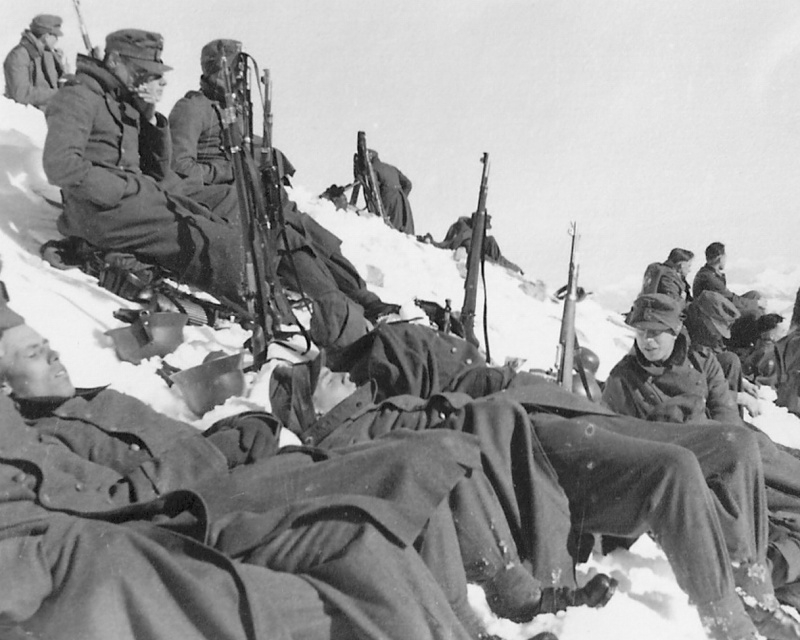
Some Gebirgsjäger catch the rays of the sun during a halt.
The Russian soldiers, however, and this despite a shorter supply route, were even worse off than us. The Red Command was more concerned with bringing ammunition rather than rations up to the front line, and their troops lived on a diet centred around biscuits in the autumn and porridge in the winter. They also had a sort of pre-cooked rice and sugar. That, and a small pouch of tobacco among four men, completed their rations.
Prisoners told us that in their supply columns each man carried 10 to 12 kilos of supplies or ammunition in addition to his own equipment. Each company had its own column which brought up only ammunition or supplies, never rations, and the march from the railhead to the front line took three to four days. Pack animals were used to bring up the heavy equipment, but the animal losses in winter were so great, with the poor beasts freezing to death on the open peaks, that their use was discontinued and Ivan, the Russian infantryman, struggled through the deep snowdrifts bringing up the ammunition. When the weather was so bad that the supply columns failed and all the rations had been eaten Ivan's officers told him "Take what you need in the way of food from the German invader" and then they would attack us to seize our own meagre rations. As prisoners they were surprised at the quantity and variety of the food we received, although our rations were by that time quite poor.
It is almost impossible to imagine warfare in the high mountains. The air is thin and every moment, every step, is tiring. The lungs are starved of oxygen, and even thinking becomes an effort. Our attacks against Ivan or his against us were not the mass assaults of battalions, regiments or divisions fighting for strategic objectives but instead small groups of ragged men moving slowly and carefully across frozen wastes to take out a single machine-gun emplacement.
The enemy attacks. At first he tries to go around [Colonel] Le Suire
and his group and outflank them from the other side of the
Elbrus Massif, but his attack is stopped 6km from Chursuk.
Ragged? Yes, we were—and crawling with lice, too. We were all unwashed, unshaven, and all had frost sores on our faces and hands. Our uniforms, worn continuously for weeks on end, were in rags. Our boots were wearing out. Everything was becoming worn out and useless. We must have stunk as well, but were only conscious of smells when we took Ivans prisoner (and the Ivans did stink). By the end of September [1942] our battalions had sunk to the strength of companies of no more than 50 men, and some of our heavy units could not be deployed as there were no men to man them. The line was being held by small battle-groups who held sectors in most cases far too wide for them to cover adequately. Our patrols would range across the sectors, up and down the valleys which were on our part of the front, and in the front line there would often be only two men and a light machine-gun every 50 metres or so. That was all the strength we had. Before us lay Ivan, and behind him lay Asia.
By the onset of winter, visibility was almost down to single metres for much of the day. The afternoon cloud masses of autumn no longer dispersed, and we lived in an opaque, twilight world of continual snowstorms. Through these swirling clouds of snow we would go out to attack some small irritating Red outpost and we would traverse the snowy slope, sending out light machine-guns on the flanks to give covering fire while the main group went in with hand grenades or entrenching tools. Combat on the peaks was nearly always a matter of close-quarter fighting. Almost anything explosive, like hand grenades or mortar rounds, lost half their effectiveness in the deep snow.
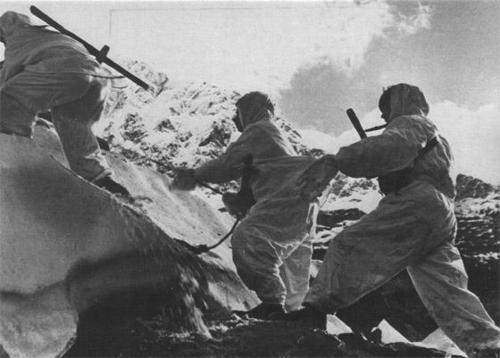
Red Army soldiers in the Caucasus.
When Ivan attacked there was none of the "Ooraying" nonsense which we had encountered in the plains [the Russian war-cry sounds something like a long "Hurrah!"]: up here every breath was precious and there was no shouting, even of orders. Economy of speech and gesture was the best way. They had a battle drill, and so did we; orders were unnecessary, and the objectives of most assaults at platoon or company level were in any case tactical—intended to dominate no-man's-land, not to capture more ground.
During the worst winter period the Soviets moved back into the comparative warmth of the woods on the southern side of the range. Their front line was then held by cadets from military academies, but even they deserted to us. Poor devils: they were completely new to mountain warfare and especially to battles in the depths of winter. Their rations consisted of cubes of frozen dried bread and cubes of frozen, dehydrated salt meat. They had to suck these slowly so as to extract the maximum benefit. Their Komsomol [the Soviet Union's official "Young Communists" organisation] Communist Party books were of little use to them up on the peaks, and they died in scores from exposure and as a result of bad leadership. From lieutenant downwards, in fact, standards of leadership in the Red Army were abysmal, and non-commissioned officers, usually the back-bone of any army, seemed to be completely useless—certainly in abnormal conditions.
German mountain troops escape from the freezing winter weather
and share a meal in their snow-cave.
The exception to the poor quality of our opponents were the men from one of the Red Army's high mountain battalions. One of these men deserted on his second night in the line. He couldn't stand the cold and the loneliness. According to our Intelligence officer's interrogation report, there were five battalions of these troops, all in action in the western Caucasus. They wore no steel helmets and were equipped with a higher than average number of machine-pistols, light machine-guns and mortars. Other than that, they had little in the way of specialist equipment, although each had been trained for three weeks in the use of crampons, ice-picks and ropes. Their rations were soup in the morning, a millet porridge at mid-day and soup or porridge in the evening. On active service 35g of sugar per man was issued daily together with 500g of biscuits and a fifth part of a tin of meat. The specially prepared, high-Alpine diet of concentrated foods that we could quickly turn into hot, nourishing dishes were completely unknown to them.
I do not know how their wounded were evacuated but on our side to be wounded badly enough to be evacuated was to enter a private hell of suffering. With light wounds one stayed in the line, hoping that the injury would not turn septic and gangrenous; one went for a dressing and returned to the company position again. It was a matter of honour not to leave the line for superficial wounds. Those injuries which were so bad that walking became impossible were an unimaginable calvary: in addition to the shock of being wounded and then the pain of the injury itself, there lay ahead three days of portering, of being carried on a stretcher by relays of men down to the nearest main dressing station. Eight porters were required per stretcher—four to carry and four to relieve them when the first team was exhausted. A system of relay stations was set up and the wounded man would be passed through these receiving fresh treatment at each stop. In the freezing cold, usually in snow storms, or on the lower slopes in pouring rain, the stretcher-bearers would inch their way down the sodden, greasy surfaces of the mountains, thankful when a stretch of flat ground made the going easier. At a main dressing station accommodation was in wet tents or damp dug-outs. In fine weather a Fieseler Storch [see above] would sometimes fly out two wounded men with each air-lift, but in winter the onward journey had to be made by ox-cart or on a panje waggon [a small wooden cart with a canvas roof drawn by a pair of horses]. Many never reached that stage of evacuation: by the time the wounded man had arrived at a main dressing station his injuries would have suffered complications through the cold and the lack of correct treatment, or simply because he had been dropped by his bearers when they came under mortar or sniper fire. Legs shattered by shellfire would become so putrefied during the long journey down to the dressing station that amputation, usually by the light of a hissing carbide flame, was the only way of saving the soldier's life. Germany in the first post-war months, before the bulk of men held as prisoners of war returned, was a land of one-legged or one-armed cripples.
The seriously wounded are carried down from the Elbruz area over the Chotiu-Tau Pass
by four-man stretcher teams, with a second team of stretcher-bearers ready to relieve the first.
The depths of winter increased the misery of the wounded: cold produced apathy which in turn lowered resistance and the will to fight and survive. To combat the severe cold sledges were filled with straw, hot stones were heaped around the wounded, and thermos flasks of hot tea helped to keep the wounded conscious of their predicament so that they did not slide off into sleep and then death. The distances between relay points were reduced in the winter, wooden poles were used on stretchers in place of metals ones [skin "sticks" to metal below a certain temperature], paper bandages which retained body heat longer were used in place of linen, and regular, frequent inspections of the wounded were made to ensure that there was no alarming deterioration in their condition.
The graves of fallen Jäger by the Chotiu-Tau Pass.
Note: The photographs which illustrate the above account were all copied from Buchner's Der Bergkrieg im Kaukasus (see above).
Unless stated otherwise or obviously not the case, all the text and images on this website are © A.J.T. Bainbridge 2006-2015
Do get in touch! Gmail: alexjtb

